 |
|
Students of "Shaping the Landscape" visited Lam Tsuen, Tai Po, to create on-site work during the 2013-14 course. |
 |
|
Students of "Shaping the Landscape" visited Lam Tsuen, Tai Po, to create on-site work during the 2013-14 course. |
“Shaping the Landscape” was a teaching program about land art. It was a Common Core course at the University of Hong Kong (HKU). HKU Division of Landscape Architecture established the course, and teacher Mak Wing Sze Vincci led it. Vincci obtained a Bachelor of Architecture degree from the University of Southern California and received a Master in Landscape Architecture from the Graduate School of Design at Harvard University. Before serving as a teacher at HKU, Vincci practiced in Hong Kong and London, with projects ranging from landscape architecture to urban design. Besides teaching, she participated in the Shenzhen & Hong Kong Bi-City Biennale Of Urbanism\ Architecture in 2011. Vincci is passionate about land art, and she curated the first exhibition about Hong Kong’s land art, "LAND VISIONS: In Search of Land Art in Hong Kong," in 2016.
It has never been familiar and easy to conduct such participation and practice-focused courses in the university system. Vincci successfully applied for the core curriculum of HKU and taught six consecutive "Shaping the Landscape" courses from 2011 to 2016. Nearly 400 undergraduates from HKU participated in the course, and the students came from different faculties. One can say that it was an interdisciplinary teaching experiment project. Professor Zheng Bo of this research team documented another teaching project, "Nanting Research" , a Guangzhou-based project founded by an artist Chen Xiaoyang and the Sculpture Department of Guangzhou Academy of Fine Arts. Students visited Nanting to conduct field research and artistic creation during the five-week course each year. The "Shaping the Landscape" course took a different approach. Rather than staying in one place, it took students to different places every year, including the HKU campus (2011-12), Lei Yue Mun (2012-13), Lam Tsuen (2013-14), Lai Chi Wo (2014-15), Pokfulam/Tai Tam Waterworks System (2015-16) and Yuen Long Walled Village (2016-17).
University students often have busy schedules. Why did Vincci ask the students to do fieldwork in person when she knew the difficulties? "Observation was an essential part of the entire course. We must see nature in person to truly understand nature." Vincci shared her views with the research team. There were four themes of the course: 1) Relationship between culture and nature; 2) Overview of attempts in society to manage this relationship; 3) Land/Environmental Art as an artistic approach to advocating a balance between culture and nature; 4) Community engagement and social agenda of Land/Environmental Art. When talking about the original idea of the course design, Vincci said: "The entire curriculum design was based on nature. We always use a management way to look at the landscape and unconsciously be affected by this thinking model. I want to observe nature with my students through this course and understand the relationship between landscape and human beings through the original appearance of nature."
One of the most practical educational methods in the course is the observation method proposed by Vincci. She invited students to observe nature through substitution methods, such as imagining themselves as soil and substituting themselves into the character and life of the soil. This anthropomorphism of nature echoes its syllabus:
“Throughout the history of our civilization, humankind has worked with the environment both as a means for survival and as expression culture. It has always been a two-way relationship. On the functional aspect, we shape the land to meet the needs of our daily livelihood. (…)Yet, at the same time, the environment also governs how we live. A classic example is how some coastal settlements have a tradition to live in on-stilt housings – an illustration of how the potential floods and constant change in water levels influence the way we live. Different environments also nurture different cultures, and these various cultures also shape the landscape in different ways as expressions of their various ways of life. (…)
Through the prism of Land Art, students can explore the dynamic relationships of how human culture can best work with the natural environment. By examining some of the successful Land Art pieces, students are expected to be inspired about what a healthy/balanced relationship between culture and nature could be and will examine the inter-relationship and the inter-connectedness between culture and environment. (…)”
In the 14 weeks of each semester, the teacher, teaching assistants, and students spent about 140 hours finishing the entire course. The course was divided into two parts. The first was the theoretical part, which talked about the relationship between human beings and nature, and then introduced examples of different land arts to students. Readings in this section include Daniel Boltkin's “Discordant Harmonies” (1992), Jamie Purinton and Matthew Potteiger's articles “The Wasteland and Restorative Narrative” (1998), and Nakahara Yusuke's “Leaving the City Behind: Artistic Energy in Echigo-Tsumari Art Triennial 2000” (2000), John Beardsley’s “Artists' Statements” (1998), etc. The second part was field research and creation, which was also the part where students spent the most time.
This research will record the educational methods and results of this course over the six years and will write about the details of the lessons in Lei Yue Mun (2012-13), Lai Chi Wo (2014-15), and Pok Fu Lam/Tai Tam Waterworks System (2015-16).
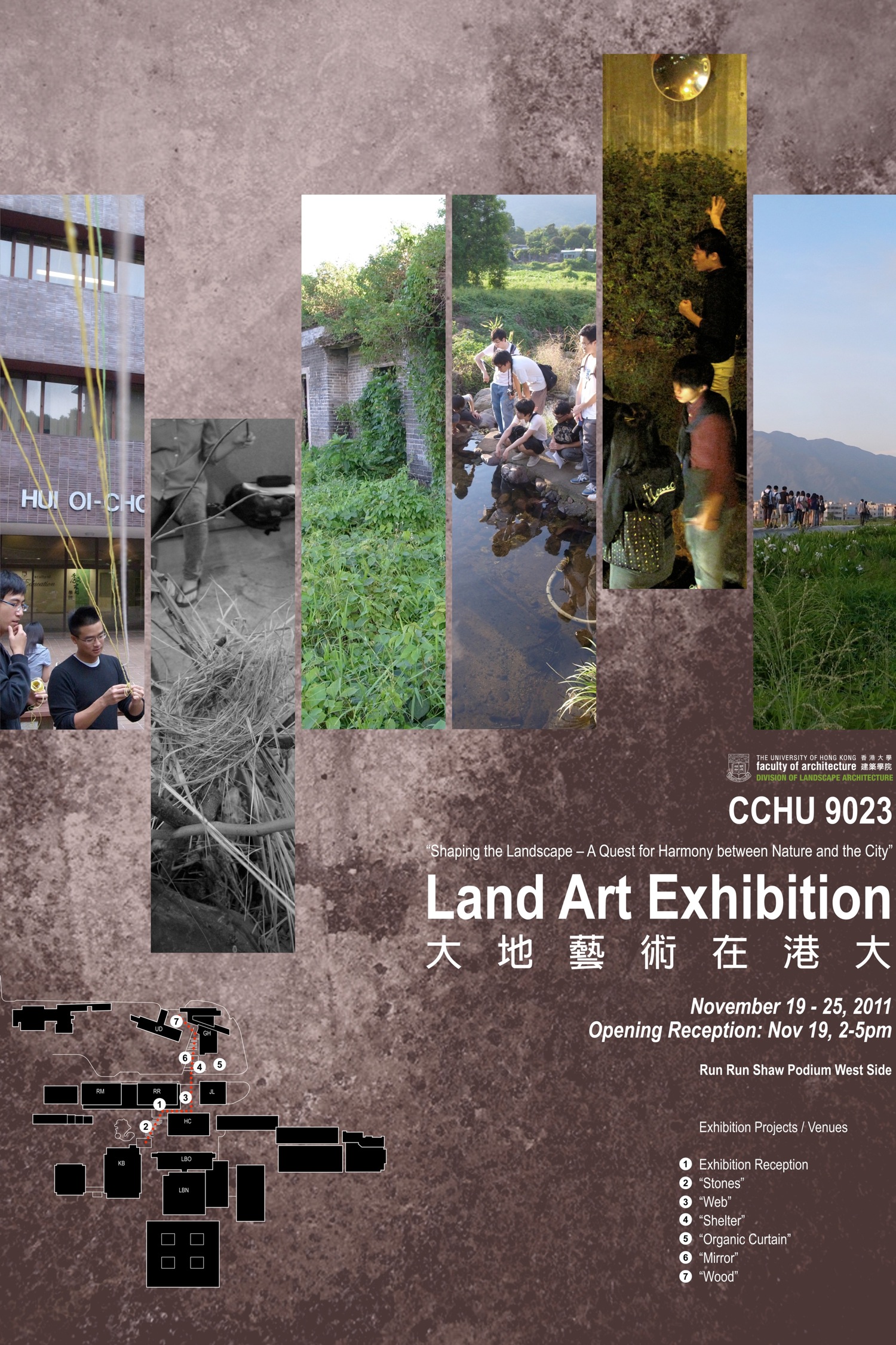 |
|
HKU launched this course for the first time in 2011-12. An exhibition was organized at the end of the program. Photo: the poster of the exhibition. |
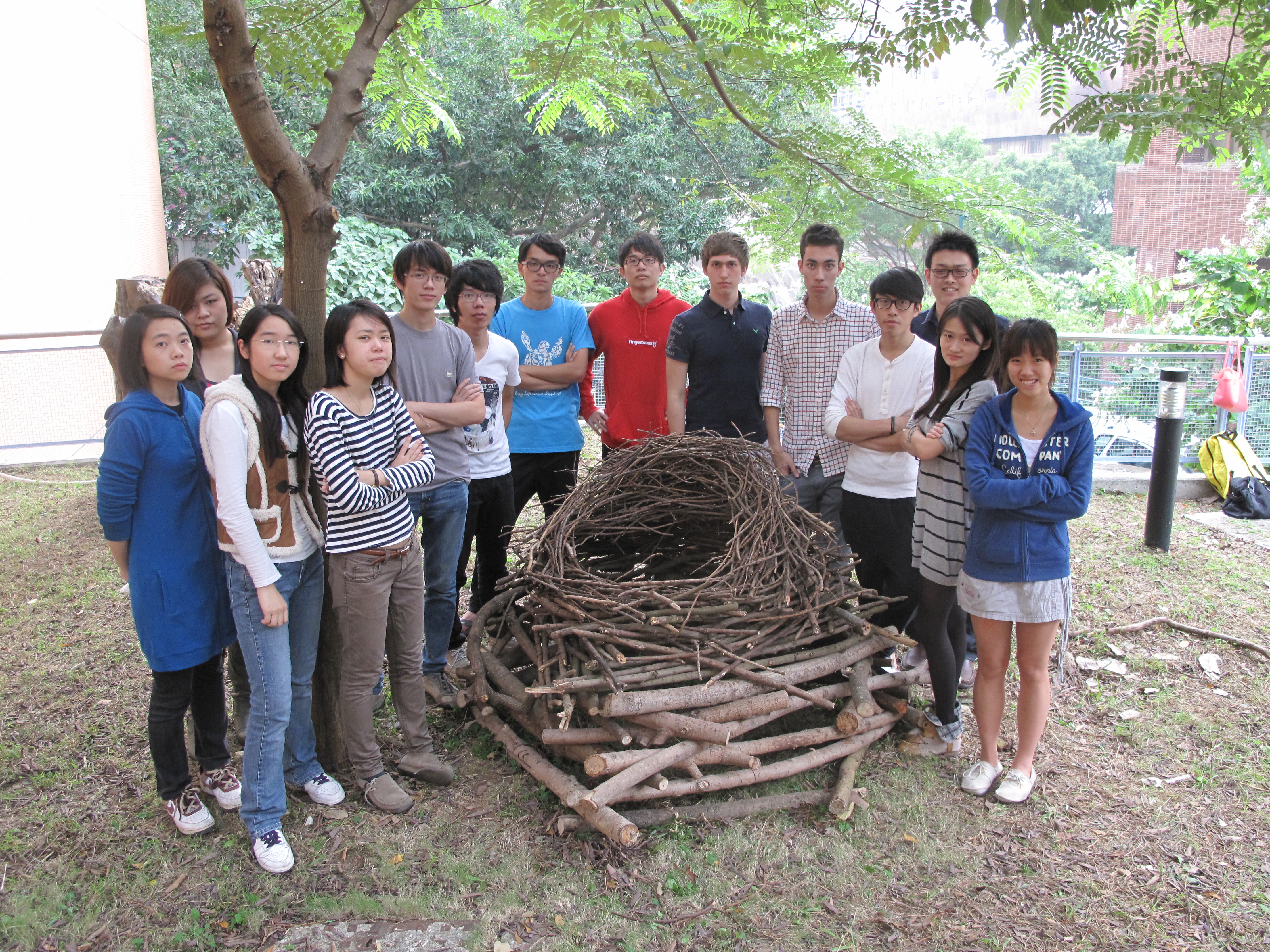 |
|
One group of students participates in the first course. They use the branches and leaves they picked up to create works on campus. |
HKU launched this course for the first time in 2011-12, and nearly 100 students enrolled. Vincci invited the students to create on-site creations. She said a group of students picked up a lot of leaves on campus. A cleaning worker said, "It's pretty, but you have to help clean it up afterward."
With the first year’s experience, Vincci moved the on-site creation site to the Lei Yue Mun Old Stone Quarry in the second year. Nearly 120 students enrolled in that year, a total of 8 groups, each group of 15 students had made eight different creations in Lei Yue Mun.
With the themes of "Fire and Wind," "Stones," "Void," "Tides," "Body and Earth," "Boulders," "Shadow," and "Ruins." Students were required to carry out a two-day on-site creation in Lei Yue Mun according to their topics, organize their creative experience with text and images, and hold a public exhibition in the Jockey Club Lei Yue Mun Plus.
The exhibition's curatorial statement: "Lei Yue Mun Village was established as a Hakka village. Hakka people first settled here due to its proximity to water. They made a living by practicing quarry mining in the nearby hillsides and sculpting the nearby landscape by extracting materials needed. Such activity created a cultural landscape unique to the village and its natural environment. However, mining activity faded away, and the tranquil village lifestyle of Lei Yue Mun is now encroached by the urban expansion in the Yau Tong area. Such tension creates ground for exploration of what landscape means to culture?”
 |
|
Students take field trips in Lei Yue Mun and create site-specific works. |
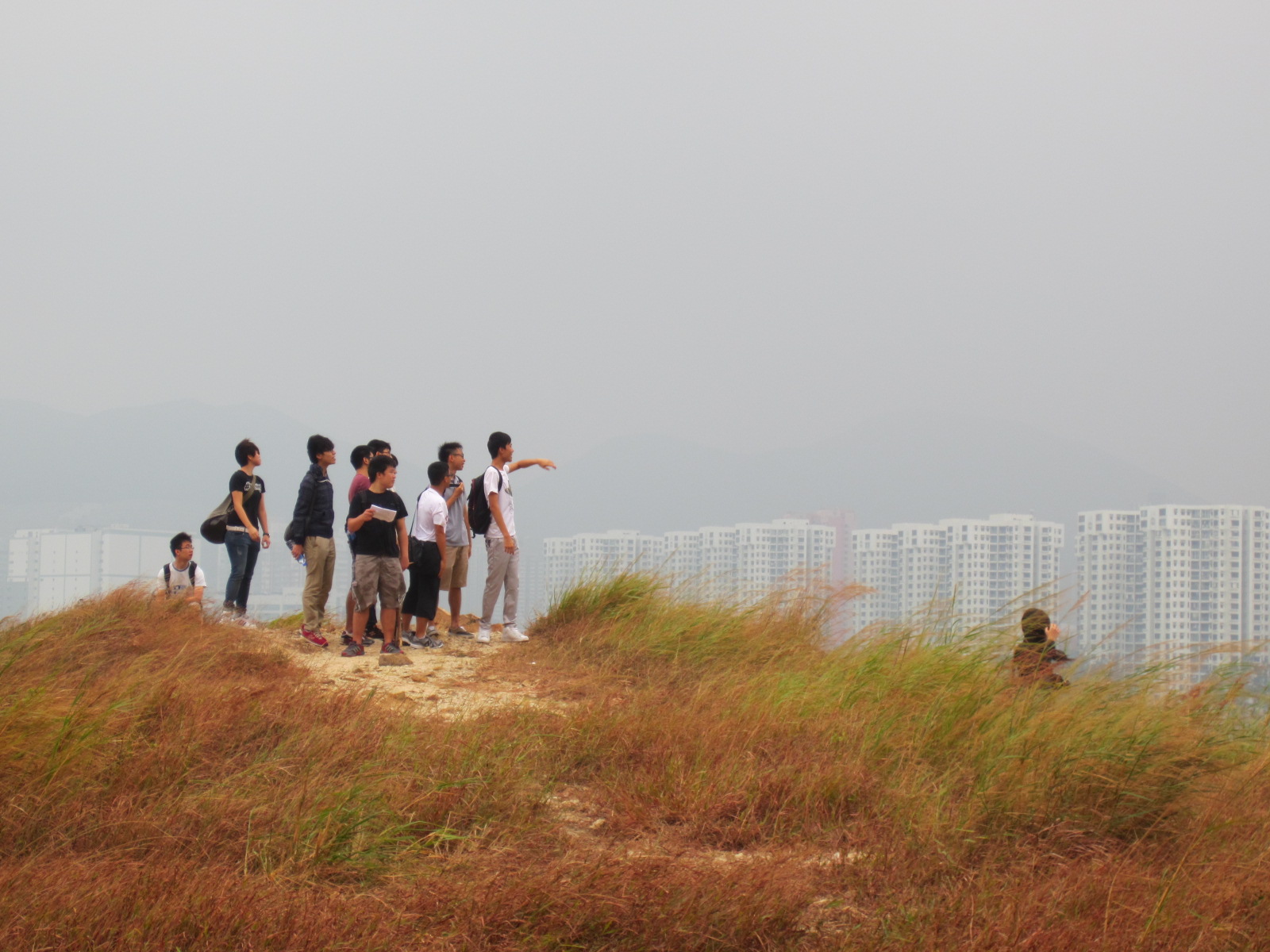 |
|
Students take field trips in Lei Yue Mun and create site-specific works. |
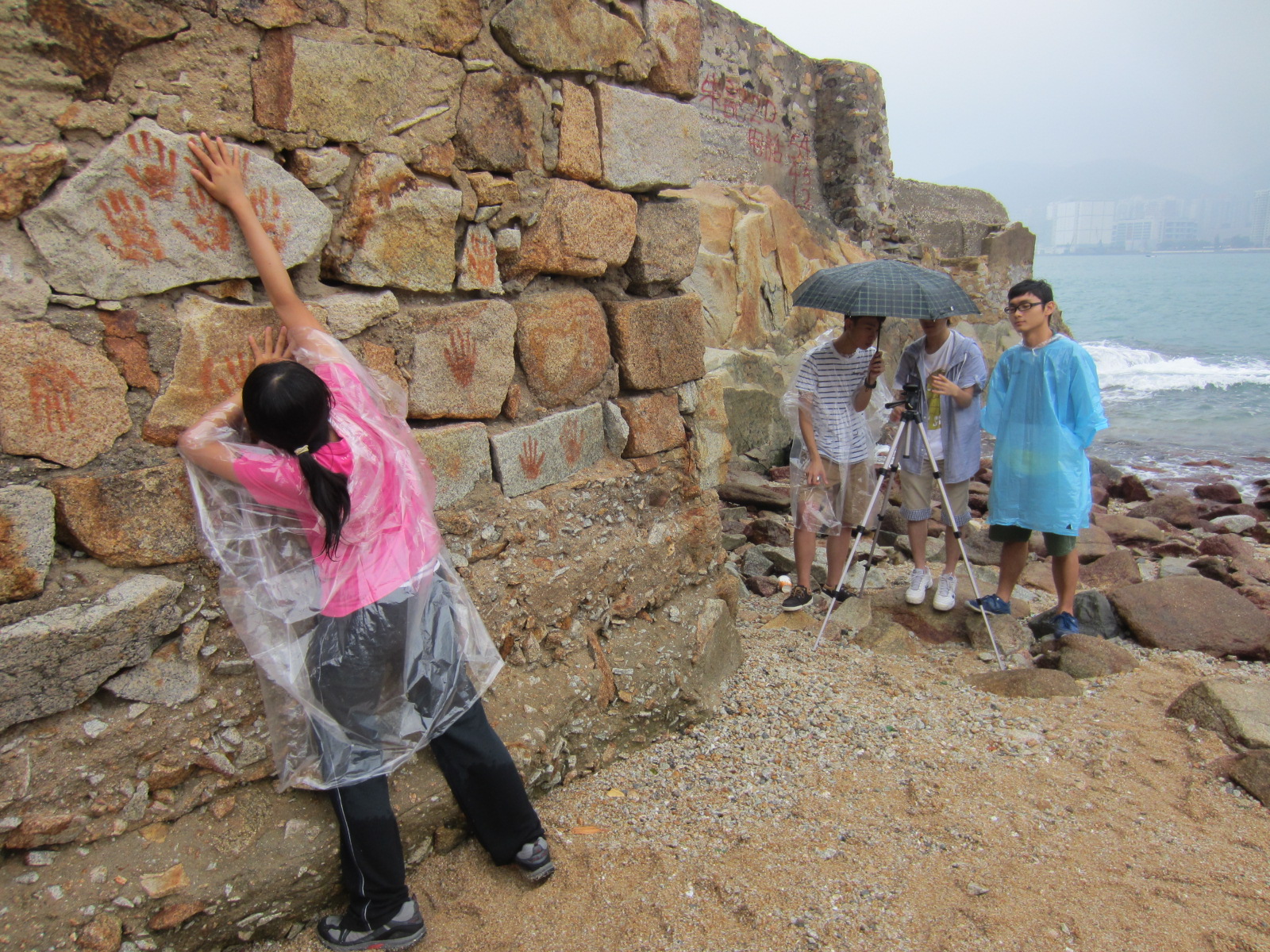 |
|
Students take field trips in Lei Yue Mun and create site-specific works. |
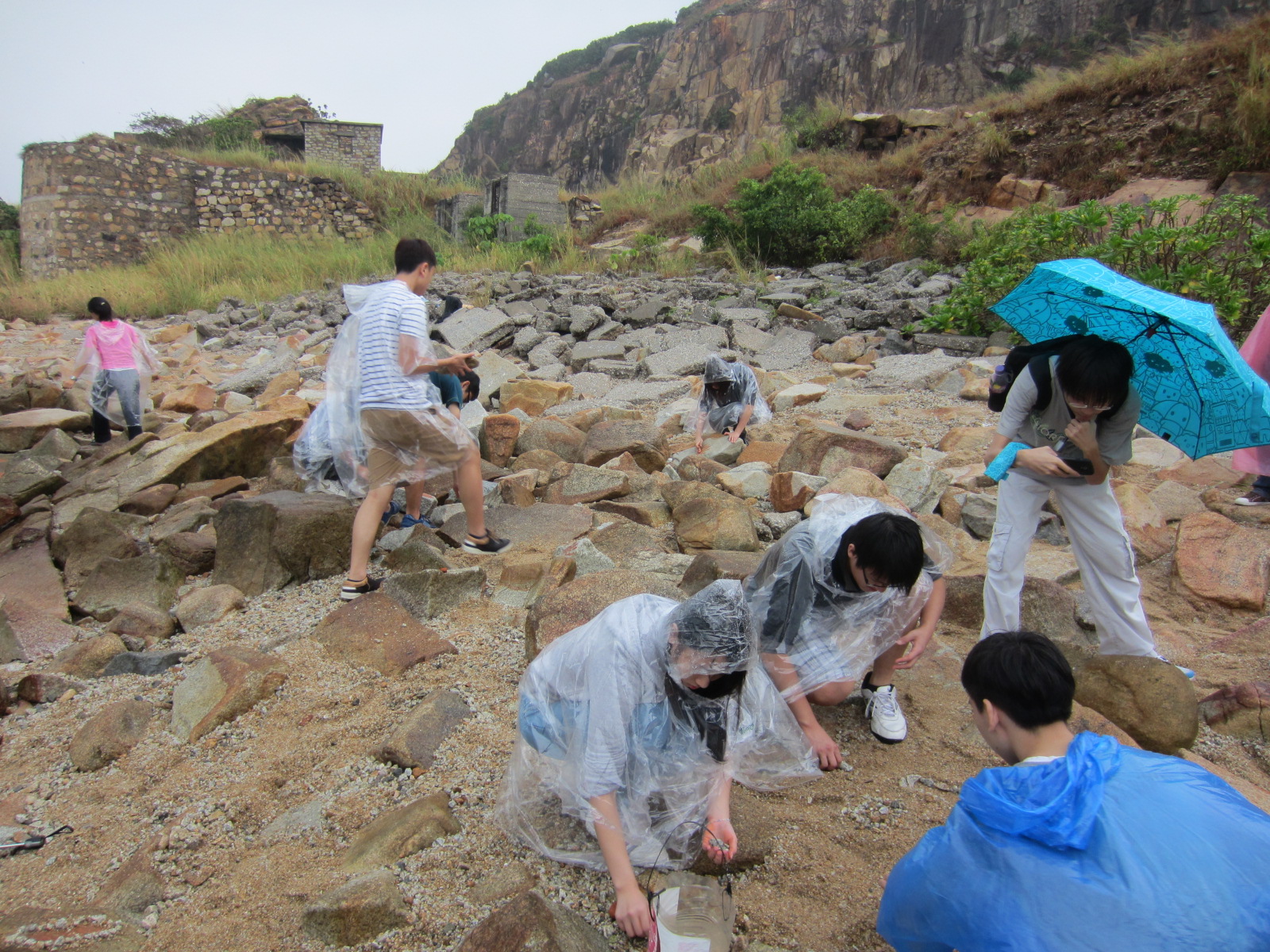 |
|
Students take field trips in Lei Yue Mun and create site-specific works. |
Students were immersed in the historical and environmental creations endowed by the venue in the course. And they observed phenomenological characteristics of the venue through colors, textures, light and shadow relationships, and history, which students reflected in the series of works. One group of students used Lei Yue Mun stones to create, mimicking Robert Smithson's spiral shapes to intervene in the space. Another piece applied a more direct approach, tying up the plastic garbage picked up on the shore with a large rock to respond to the problem of plastic waste in this place.
"Shaping the Landscape 2012" Exhibition
Date: 19 January to 18 April 2013
Venue: Jockey Club Lei Yue Mun Plus Gallery (45 Hoi Pong Road Central, Lei Yue Mun, Kowloon)
(The exhibition will form part of the Jockey Club Lei Yue Mun Plus Gallery’s anniversary exhibit)
Selected works of students
Theme: Fire & Wind
Work: “Twin Cubes”
Students: CHAN Shuk Man Marceline, CHAN Yan Yu Sussan, CHAN Wai Chun Jack, Cheng Jian, CHU Hoi Ching Charlie, HO Wing Sze Joanna, KANG Han Bit Vincent, KWOK Kwun Hang Brian, LAM Tsz Lee Lily, LIU Shan Ni Sunny, POON Wai Nang, SIT Man Yi Cecilia, TAM Man Hong Michael, TAM Kai Yip Nathaniel, TANG Pak Hin Ryan, YEUNG Yuk Chun Alex
Concept: Wind and fire are two invisible forces on the earth. This group of students built two stoves in different ways: one covers the surface with sand and mud and is placed between the three historical walls of Lei Yue Mun to form a screen; the other is built of stone and placed near the shore, letting the wind blow freely. By comparing two different stoves, students hope to awaken the audience's sensitivity to natural forces.
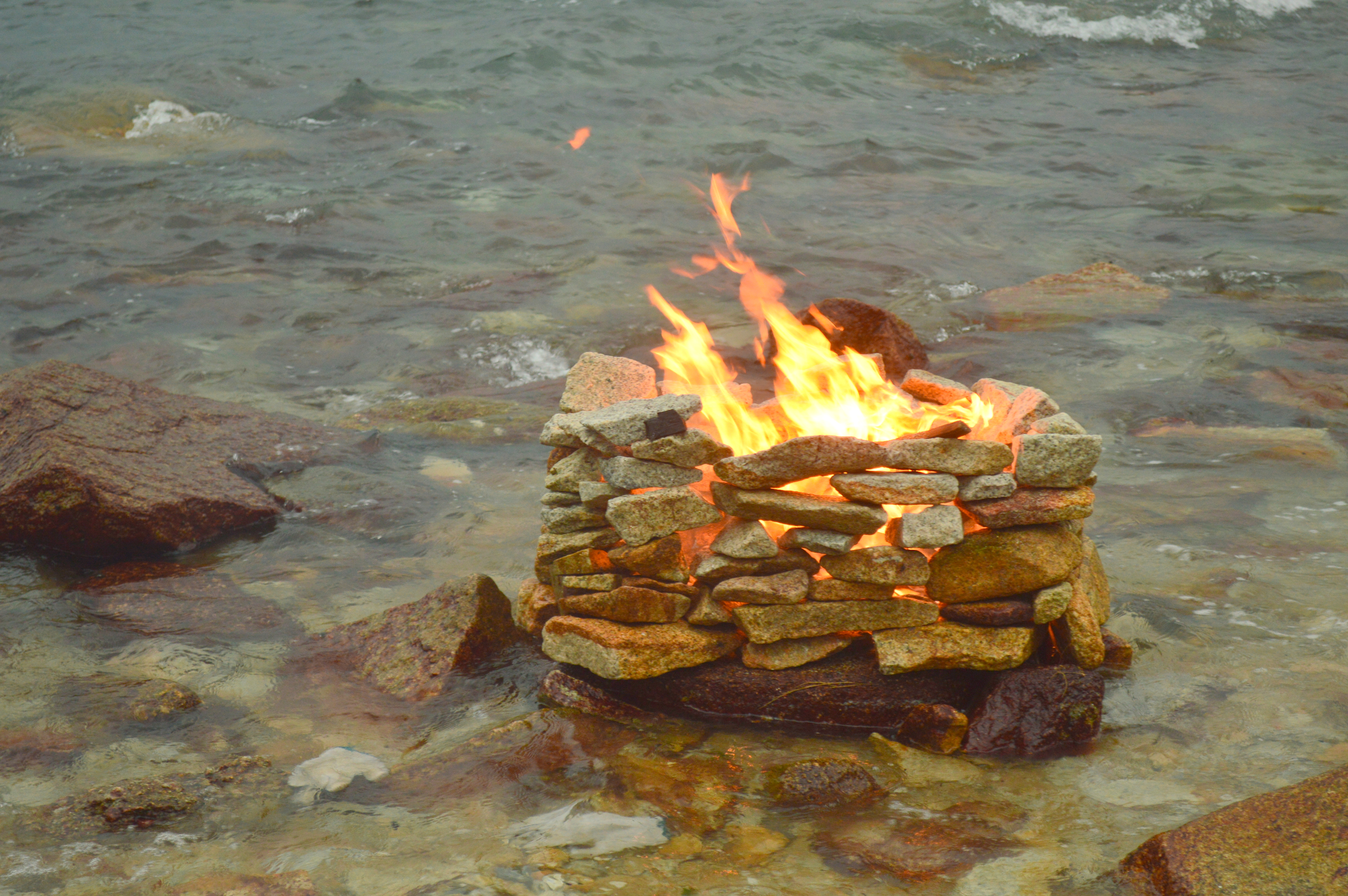 |
|
The students create the work "Twin Cubes" with the theme of "Fire and Wind." |
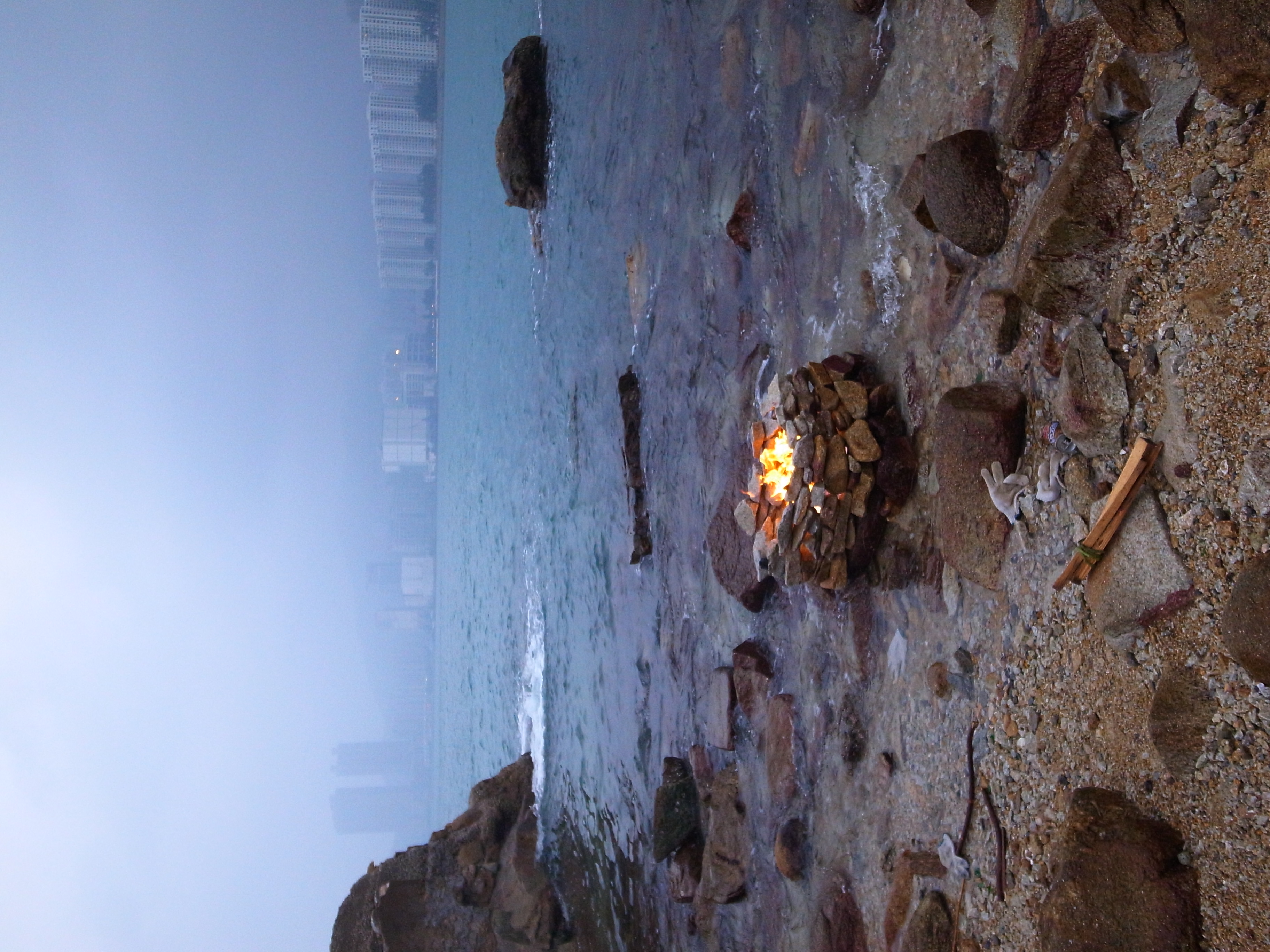 |
|
The students create the work "Twin Cubes" with the theme of "Fire and Wind." |
Theme: Shadow
Work: “Grassy Fish”
Students: Heshan Ariyachandra, CHENG Tak Hei Ivan, CHEUNG Yeung Mei, JIANG Meng, KO Ning Wai, LAM Tin Miu, LEE Ka, LEE Jasmine Hiu Lam, LUI Cheuk Man, POON Lok Ming, SUEN Wai Hei, YIU Sze Chun, YIP Ki Fung, WONG Choi Ying
Concept: The landscape of Lei Yue Mun is full of changes, and what it brings is the change of shadows in the open space under the sun. This group of students combined the history of fishing in Lei Yue Mun with the concept of shadow and used hay found everywhere to form the shape of a fishing net so that the shadow of the fishing net reappeared in this space with the sun.
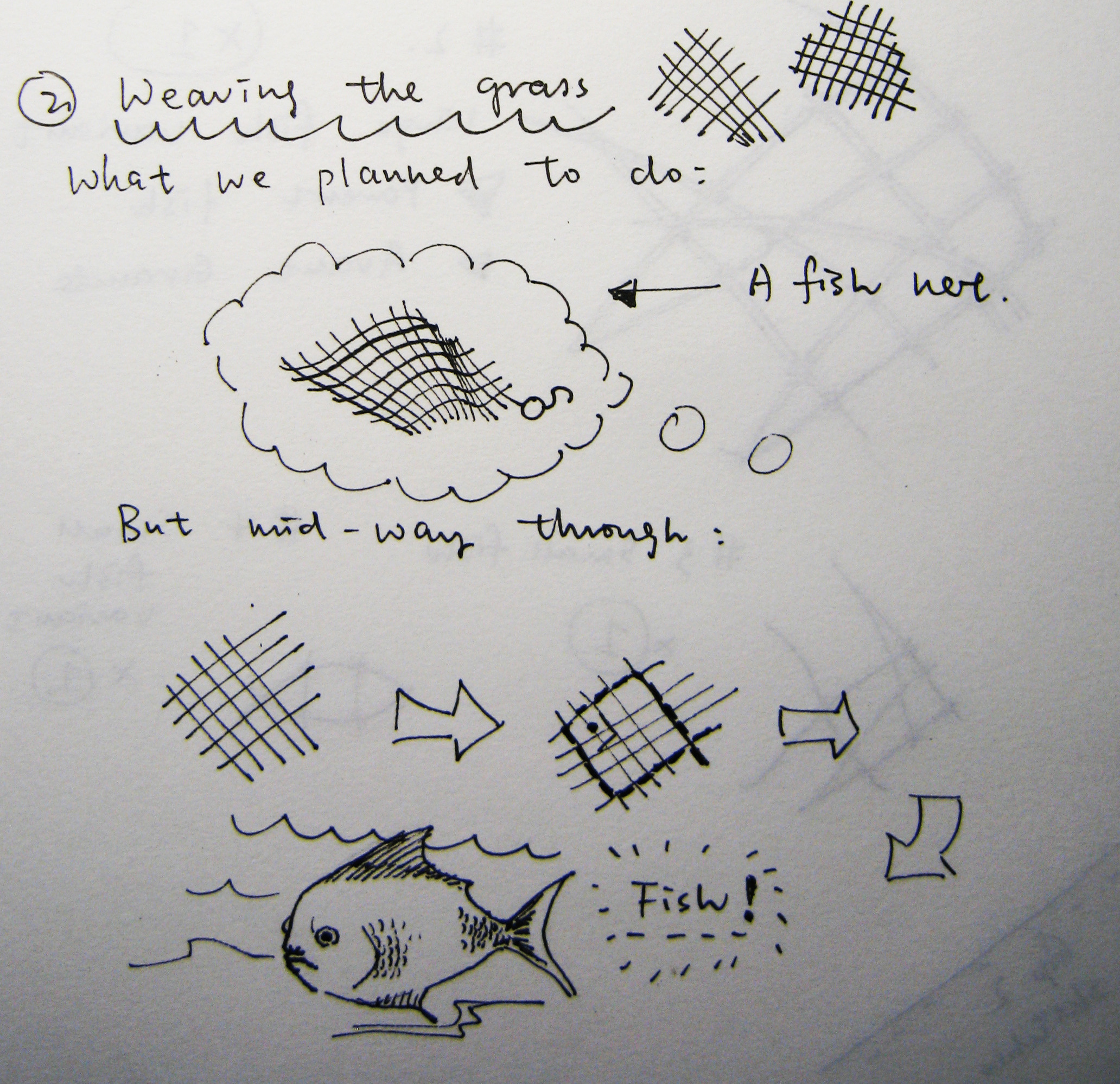 |
|
The students create the work "Grassy Fish" with the theme of "Shadow." |
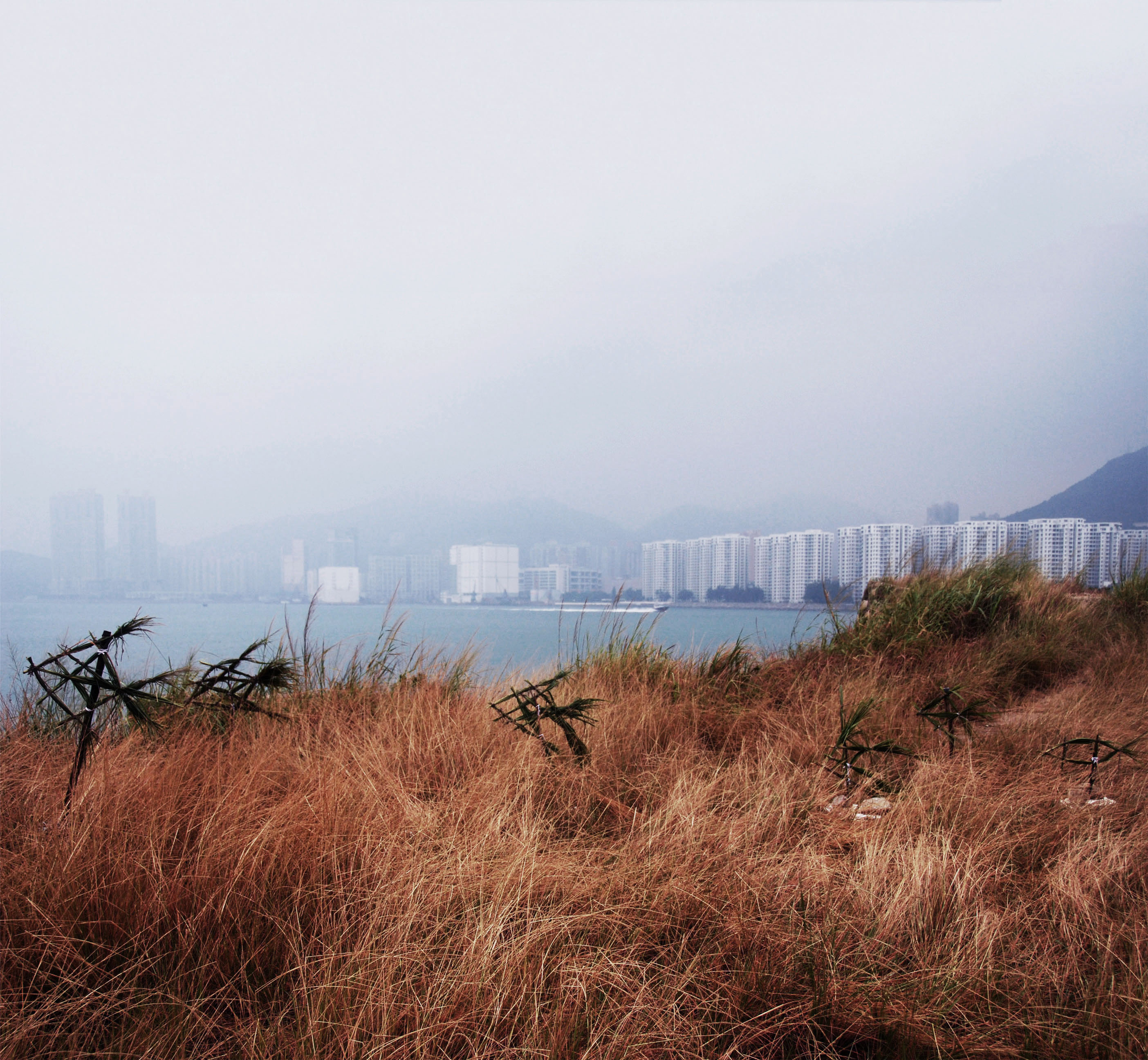 |
|
The students create the work "Grassy Fish" with the theme of "Shadow." |
Theme: Stones
Work: “Time Flies”
Students: CHAN Tsz Ho, CHAN Sze Lok, CHONG Ho Ching, HO Sin Yee, HUI Lap Yin, LAW Chun Ming, LEE KONG CHUNG, LEUNG CHEUK HIM, LI Ka Ho, Liu Tin Tsan Angus, LO Wing Tung, TANG Jestina Wing See, WONG Wing Fung, YEUNG Kei Fai, Yip Yi Kwan, Yuen Hoi Man
Concept: Every stone is different, including its shape, texture, size, etc. The stones picked up by this group of students are sorted by size. Students used the largest stones to build "stone towers," medium-size stones to build a bird nest, and the small ones surrounded the other stones in a spiral shape.
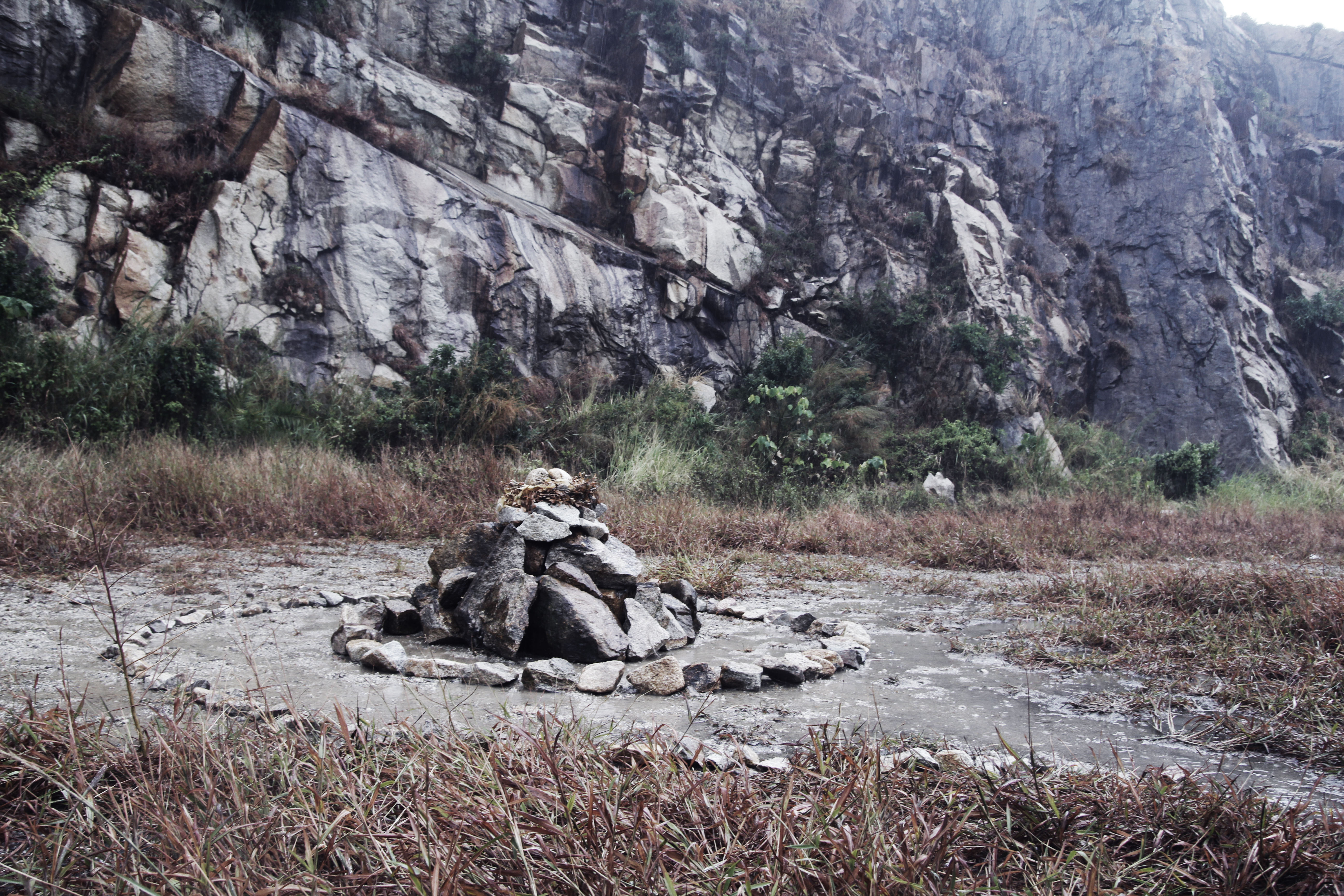 |
|
The students create the work "Time Flies" with the theme of "Stone." |
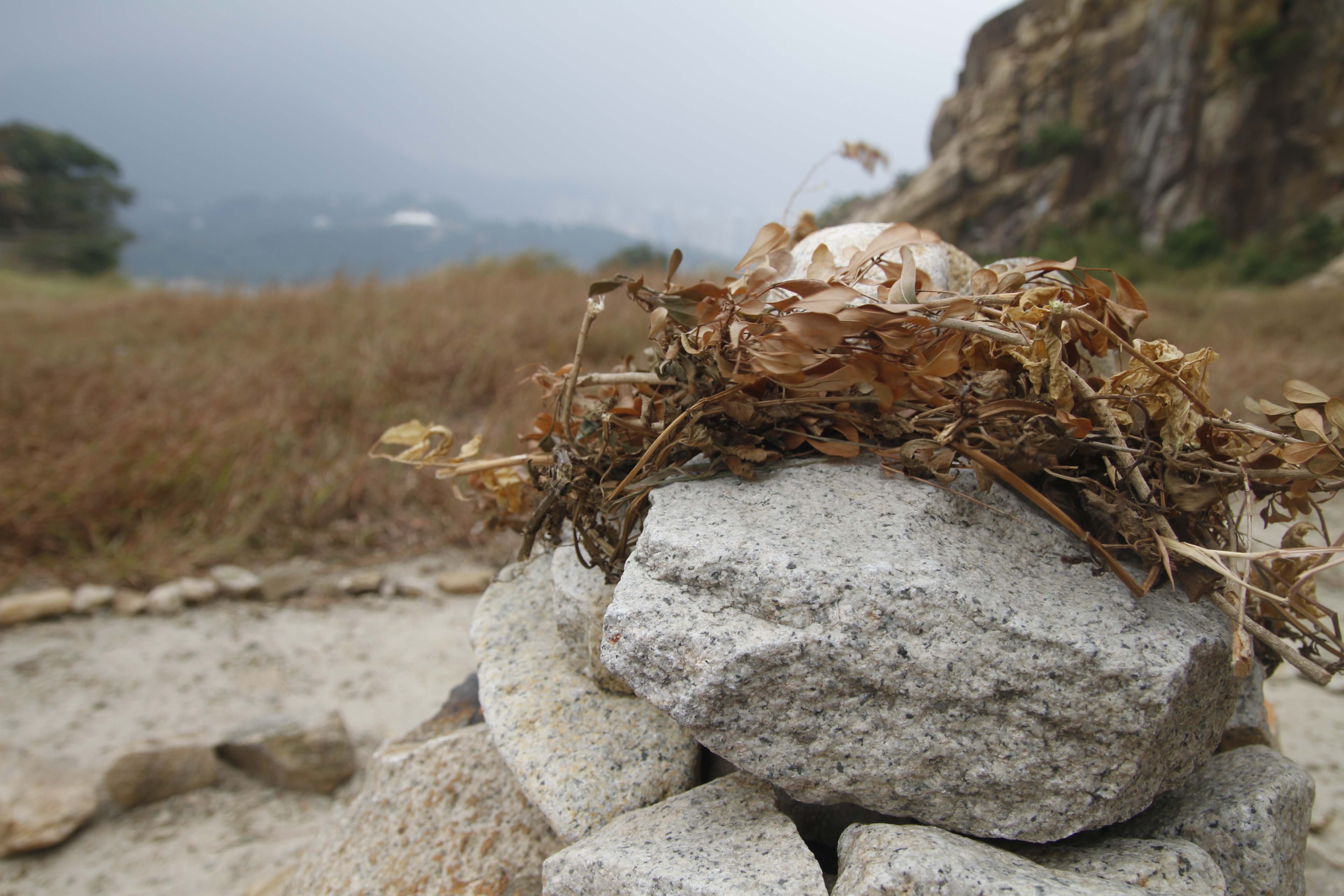 |
|
The students create the work "Time Flies" with the theme of "Stone." |
Theme: Tides
Work: “Tide Flies”
Students: CHAN Shuk Man, CHAN Wai Chun, CHAN Yan Yu, CHENG Jian, CHU Hoi Ching, HO Wing Sze, KANG Han Bit, KWOK Kwun Hang, LAM Tsz Lee, LIU Shan Ni, POON Wai Nang, SIT Man Yi, TAM Kai Yip, TAM Man Hong, TANG Pak Hin, YEUNG Yuk Chun
Concept: At the moment when the tide rises and recedes, it presents a scene where "visible" and "invisible" coexist. This group of students hopes to reflect on the past and future of Lei Yue Mun in their works. They built a stone wall with stones to surround the leaves thrown ashore by the tide. The students sewed up the leaves to symbolize people from different eras in the village.
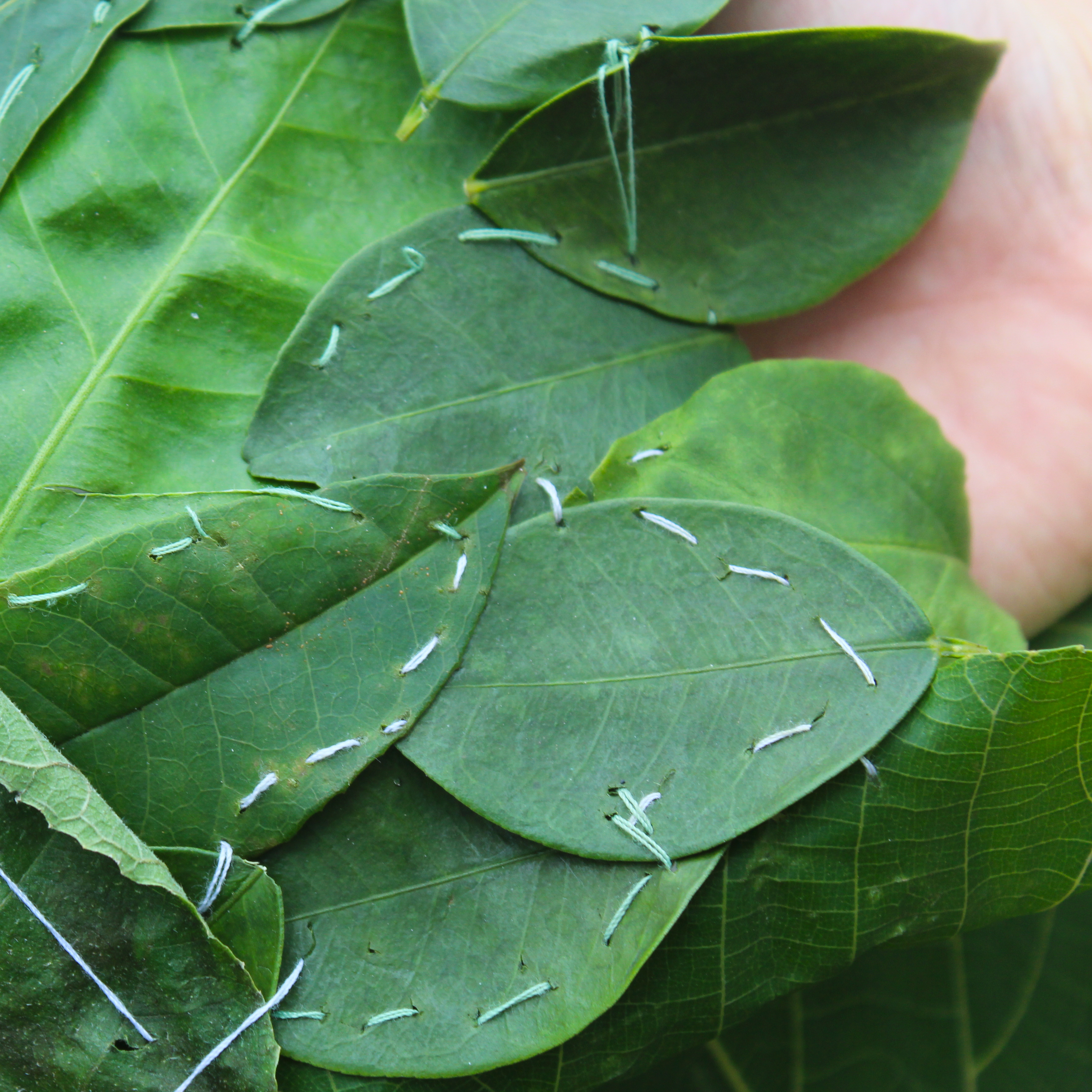 |
|
The students create the work "Tide Flies" with the theme of "Tides." |
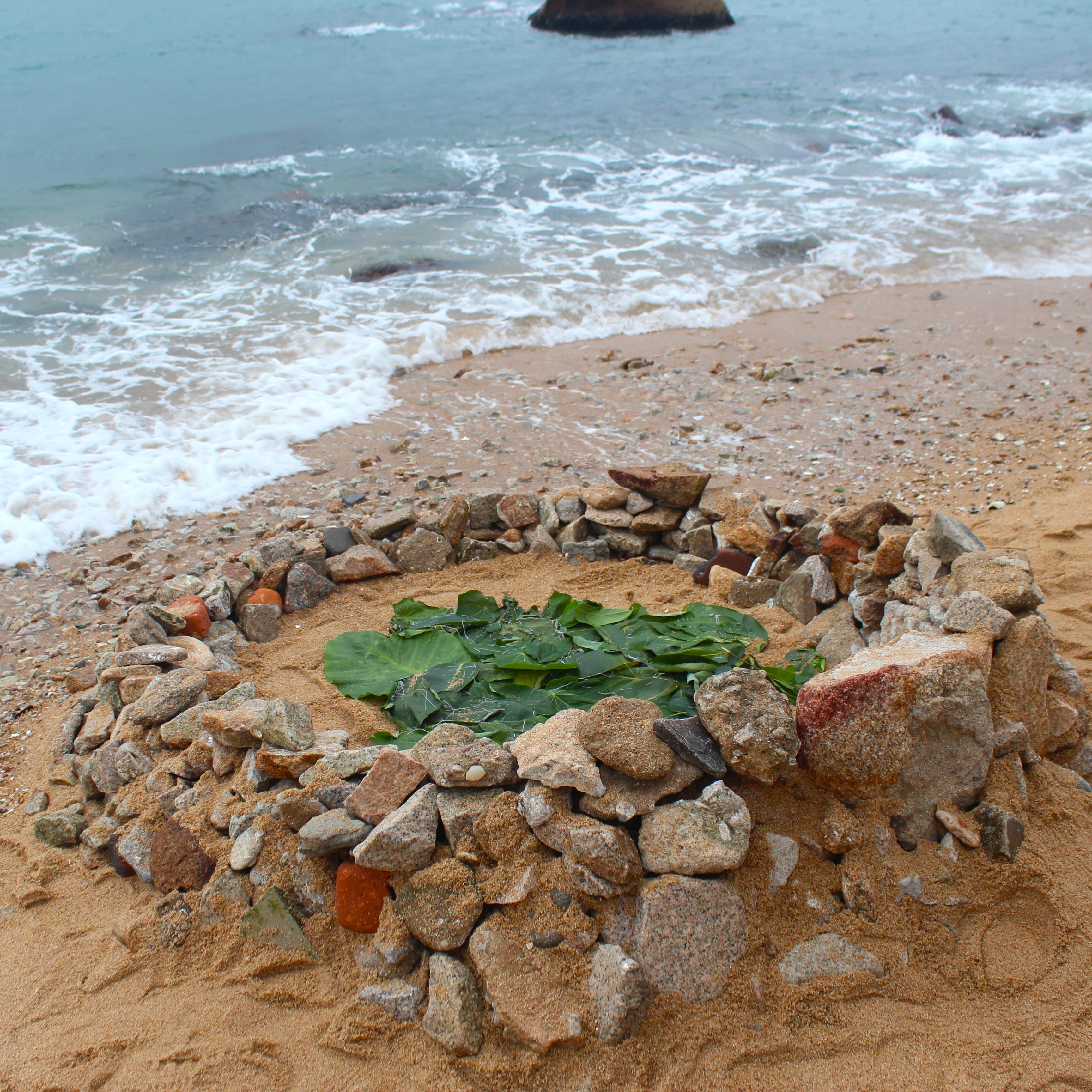 |
|
The students create the work "Tide Flies" with the theme of "Tides." |
Theme: Boulders
Work: “Artificial Nature”
Students: CAO Luca Lu-jia, CHAN Cheung Kei, CHAN Chun Ting, KONG Hoi Ching, KWAN Ching Ho, LAW Oi Tim, LI Chung Yan, LI Cheuk Man, MAN Chin Ching, NG Siu Fung, PARAJULI Pankaj, POON Hang Yin, WEERAKOON Ramesh Lakmal, WONG Shun Yi
Concept: The boulder is a big sculpture in Lei Yue Mun. This group of students imitated the shape of the boulder with the garbage they picked up. They first wrapped the plastic trash with fishing nets and then turned the trash into a stone shape step by step, hoping to arouse the audience's attention to environmental issues.
 |
|
The students create the work "Artificial Nature" with the theme of "Boulders." |
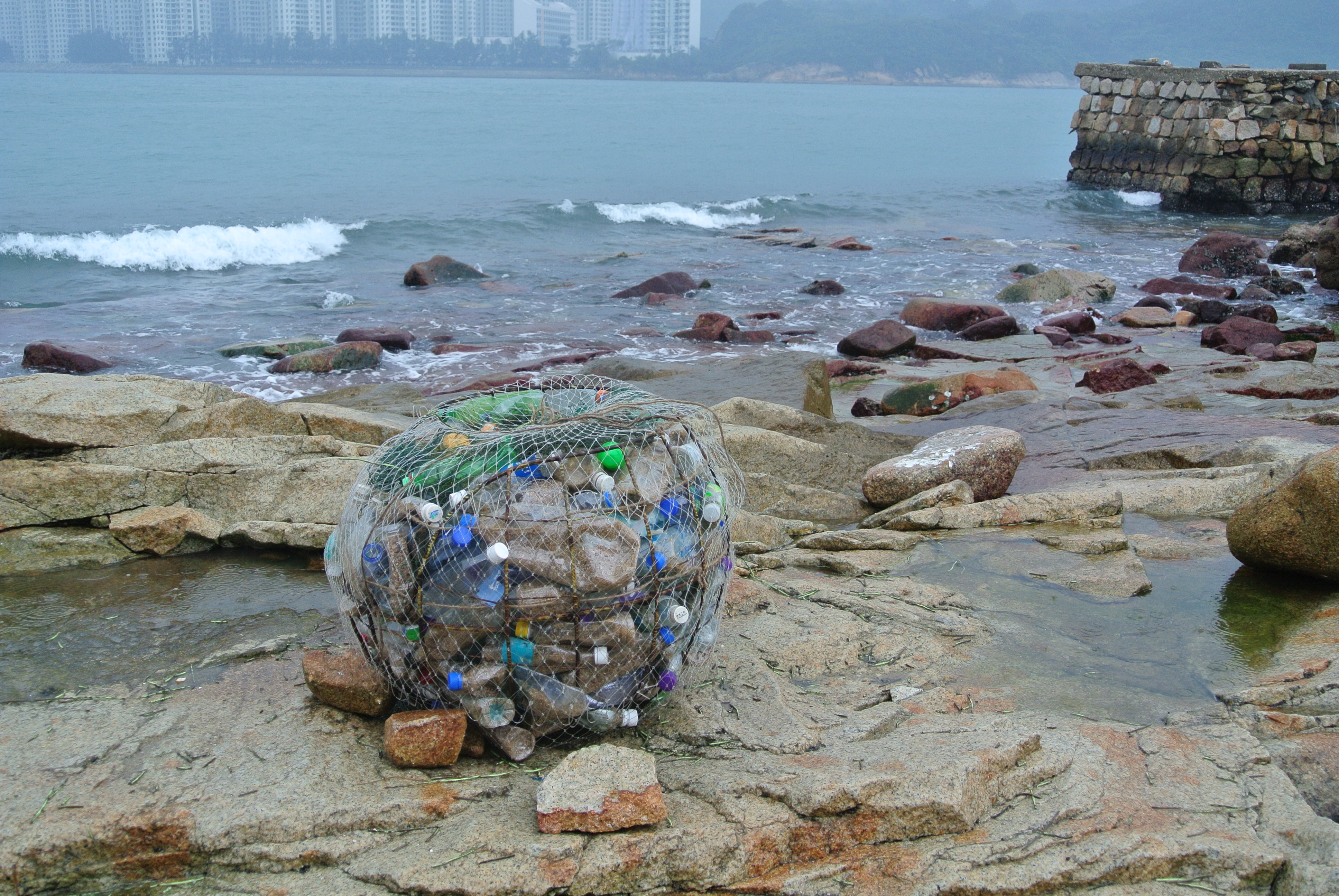 |
|
The students create the work "Artificial Nature" with the theme of "Boulders." |
Theme: Body and Earth
Work: “The Track”
Students: CHAN Joanne D. Gei Suet, CHAN Quan Chak Leon, LAW Chi Kin, LEE Yin Huan, MA Shuk Ha Kathy, MAK Tsin Yung Jimmy, NG Chau Yee Yuki, NG Yan Yan Agatha, SUNG Tin Daniel, WONG Man Chun Kelvin, YEUNG Ka Ho Matthew, YEUNG Lai Yin Carol, YUEN Man Yin Candice, YUNG Tin Mong Timothy
Concept: The land is our skin, and we are deeply connected with the land. This group of students hopes to complete the work through interaction with the space in the village.
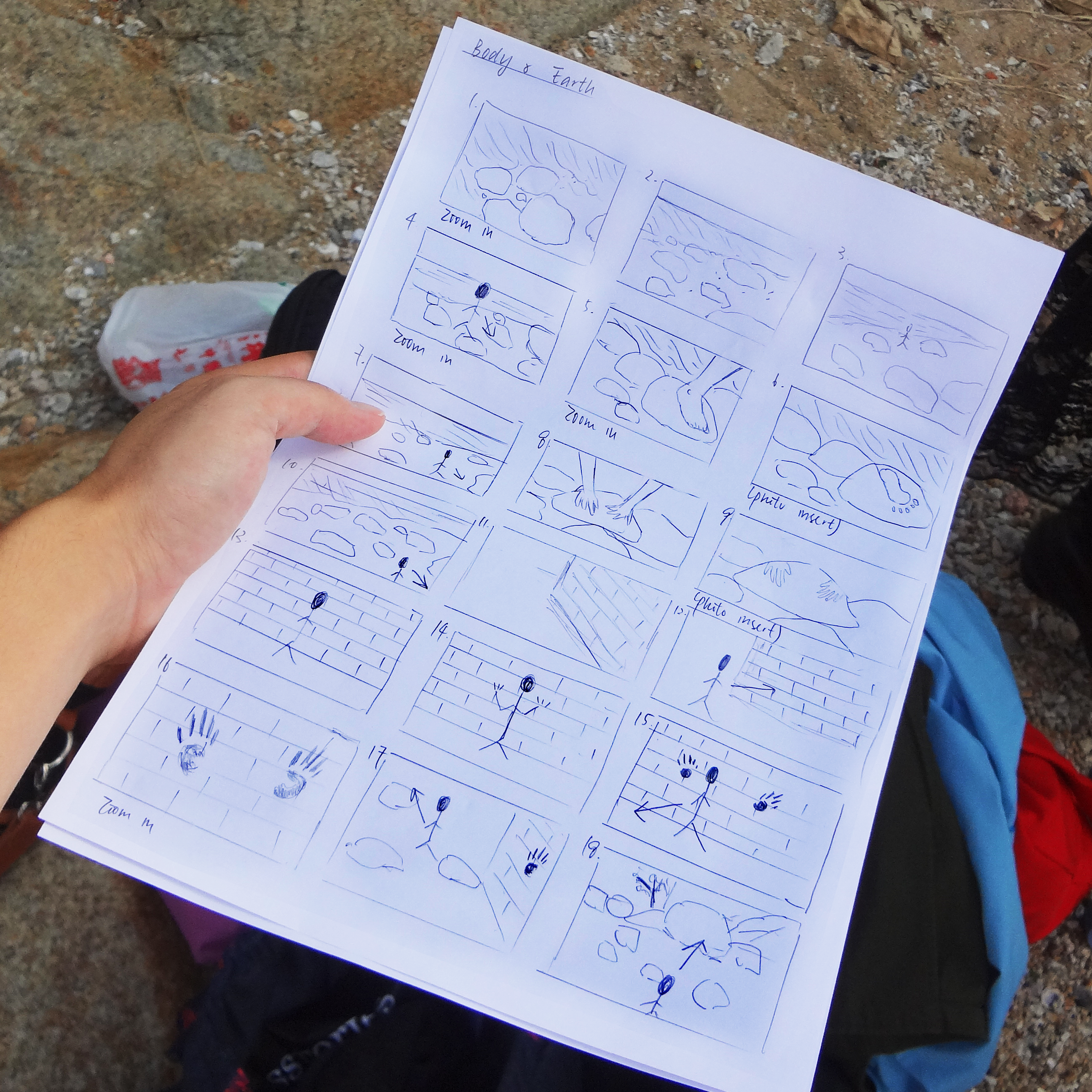 |
|
The students create the work “The Track” with a “Body and Earth” theme. |
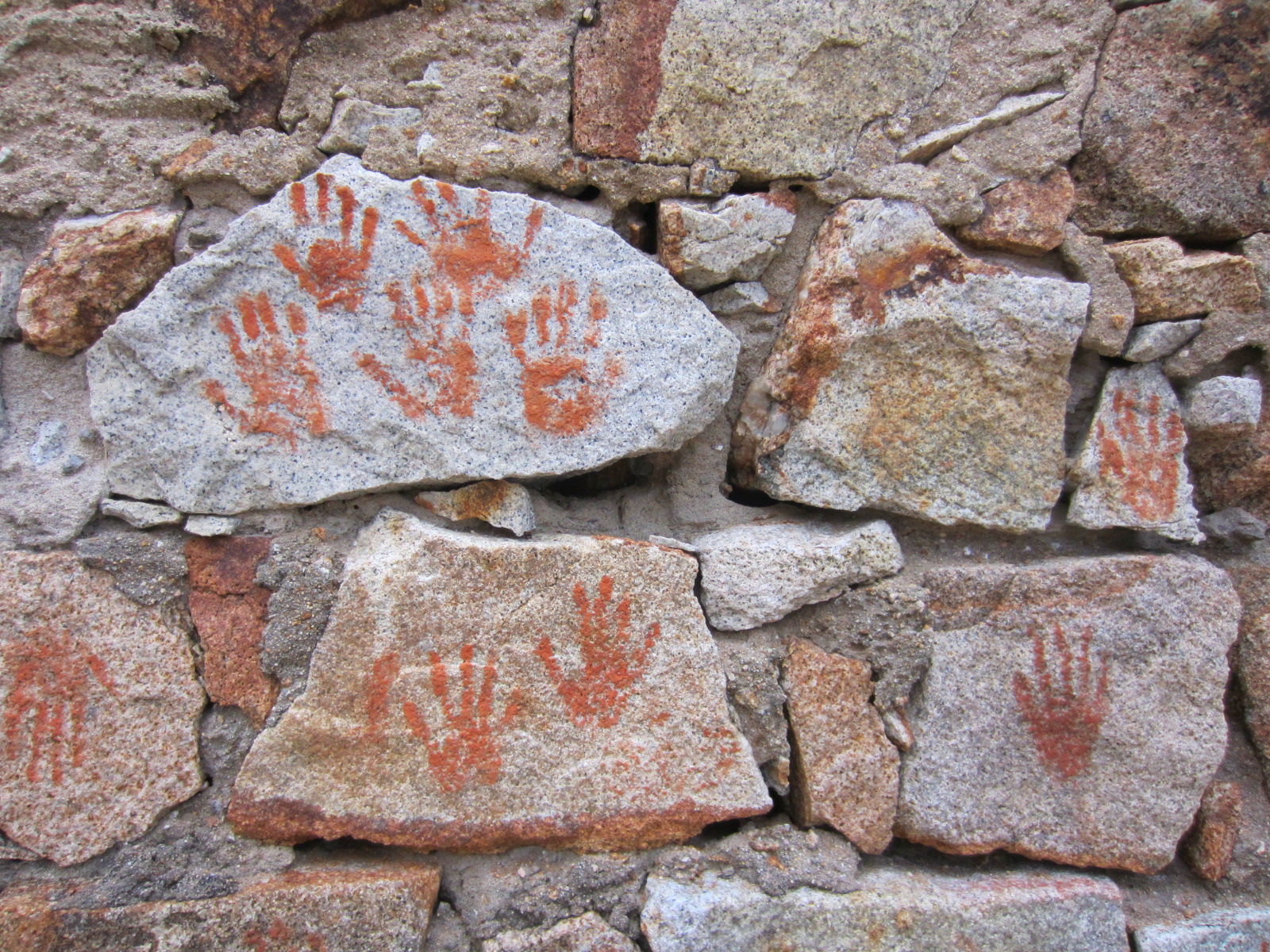 |
|
The students create the work “The Track” with a “Body and Earth” theme. |
Theme: Ruins
Work: “Gone With The Wind”
Students: AU Tsz Ching, AU Kin Tung, GUAN Wendy Yunting, HO Wing Tsit, HU Mengyu, KWAN Long Yin , LEUNG Kin Ho, LI Tsz Wing, TAM Kam Fa, TSANG Ka Long, WONG Wing Yiu, WONG Ka Ho, YU Hiu Tung, YUEN Wai Keung
Concept: The ruins of Lei Yue Mun have carried the past industrial history of this place. This group of students chose the old pier in Lei Yue Mun. They picked leaves of different colors at the dock, avocado-colored and chestnut-colored. The students arranged leaves of different colors on the old pier and recorded how they experienced the sun and rain, and presented natural "ruins" in artificial ruins.
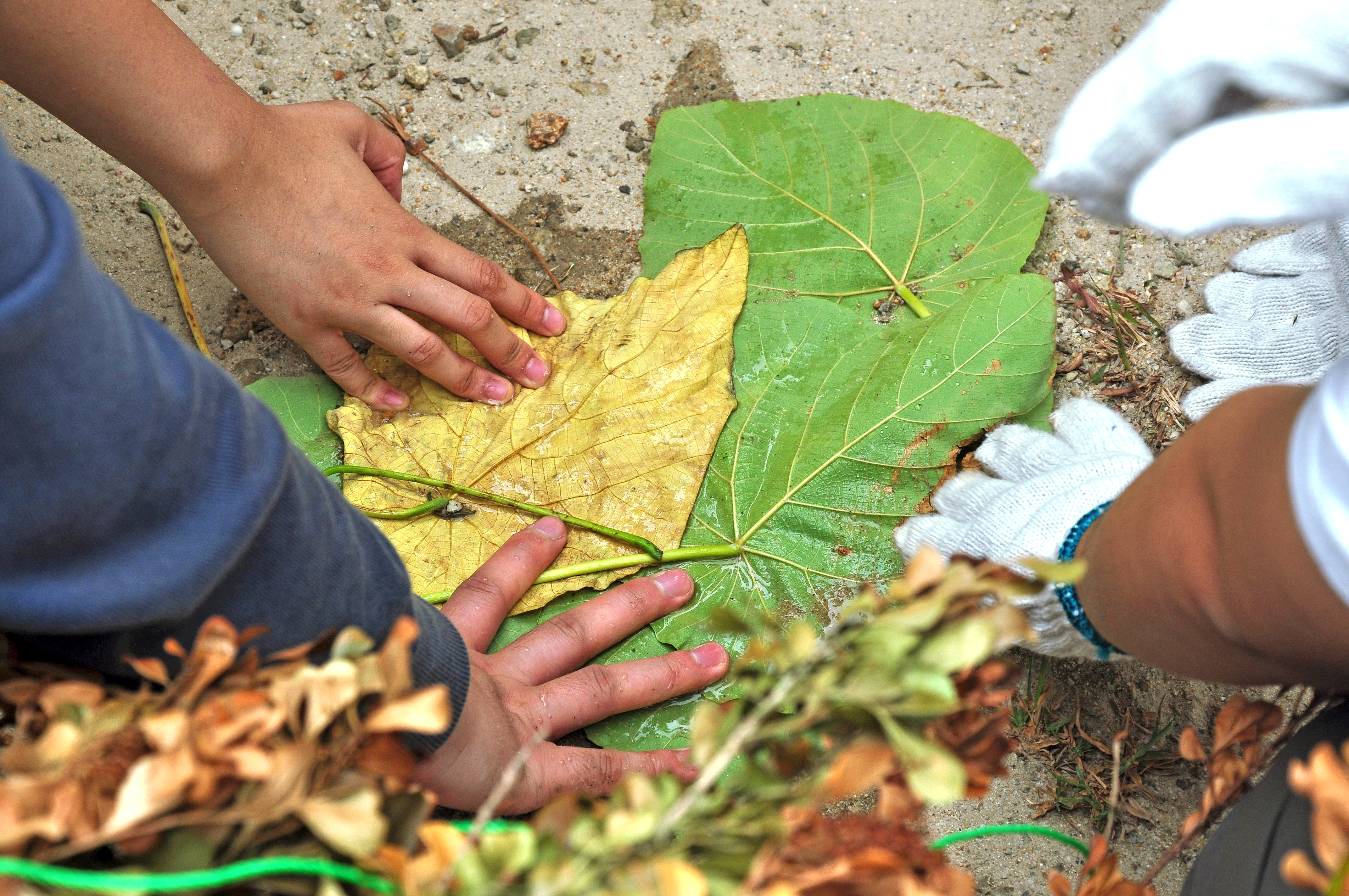 |
|
The students create the work “Gone With The Wind” with the theme of “Ruins.” |
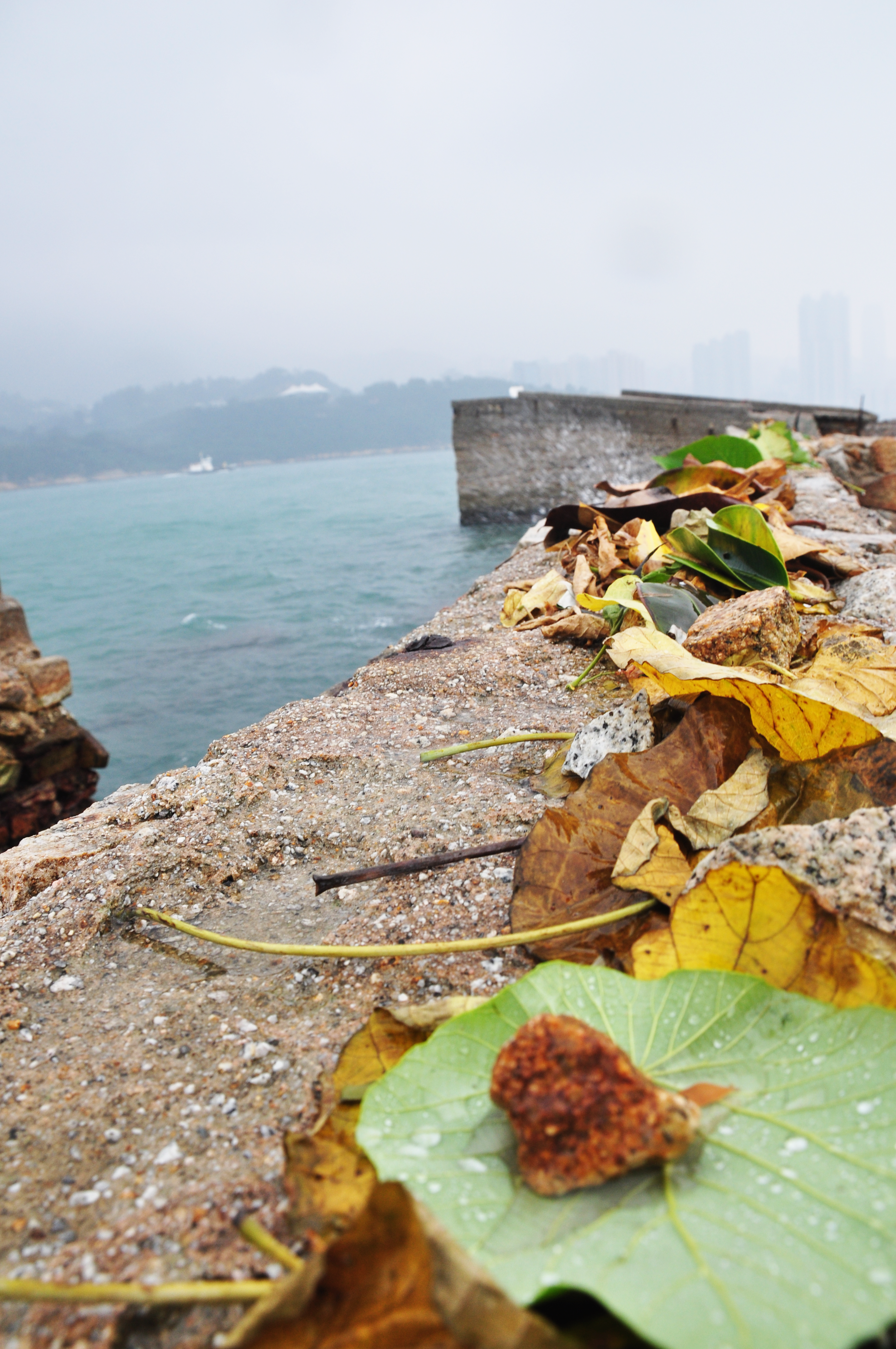 |
|
The students create the work “Gone With The Wind” with the theme of “Ruins.” |
Theme: Void
Work: “Echo”
Students: AU Lok Yee, CHAN Zheng Nian, CHANG On Ting, CHEUNG Chung Man, CHEUNG Mei Po, CHOI Desmond Man Kit, HO King Lun Joshua, HUANG I-Yang, LAO Jialong, LEE Jung Bin, NG Ka Chun, PON Chin Ching, TANG Tsz Wing Lilia, WONG Wing Tung, WONG Wing Yan, WU Yi Ze, YUEN Tsz Wai Yvonne
Concept: This group of students imagined a high mountain sitting in Lei Yue Mun, so they imitated the shape of the mountain with stones, reproduced the mountain that belongs to this place, and invited the audience to look at the sea from the gap between the stones.
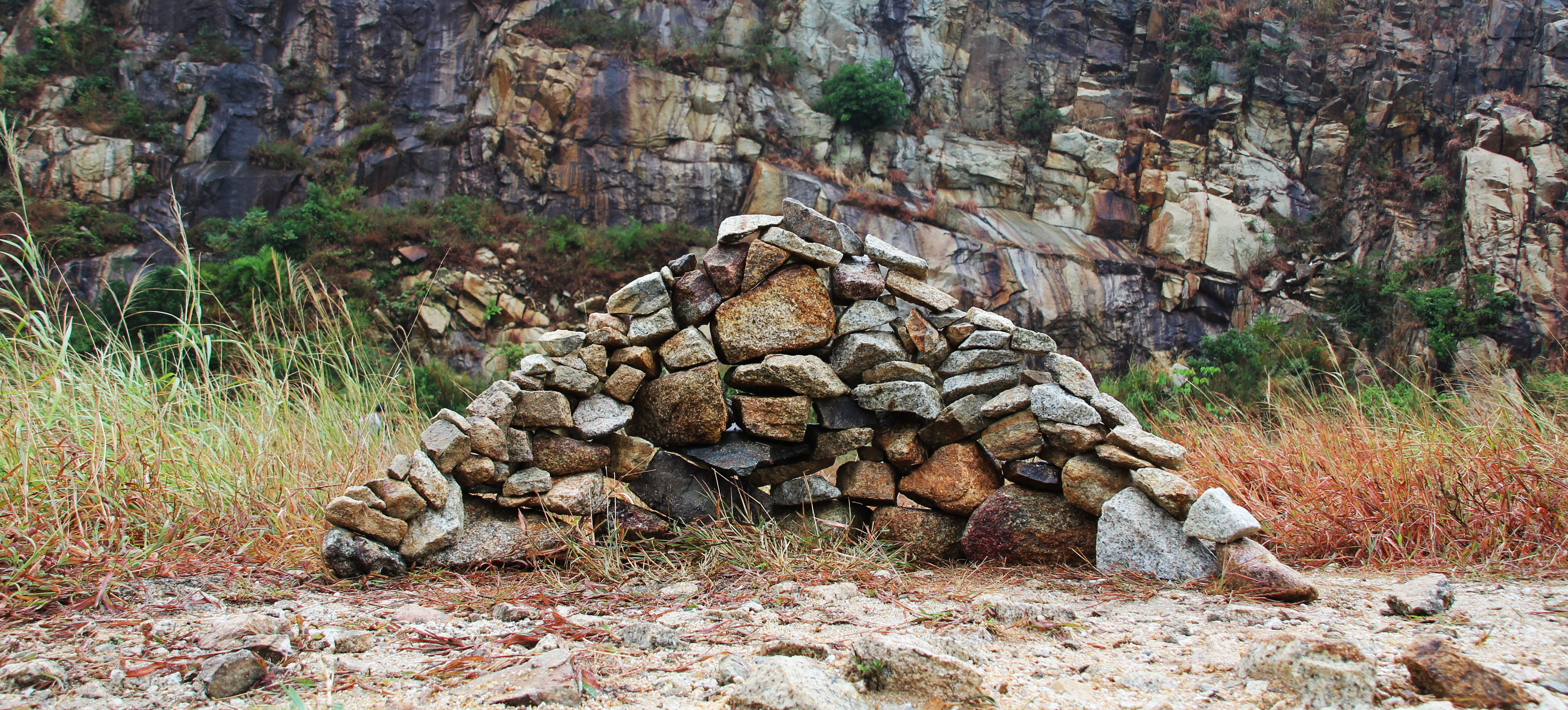 |
|
The students create the work “Echo” with the theme of “Void”. |
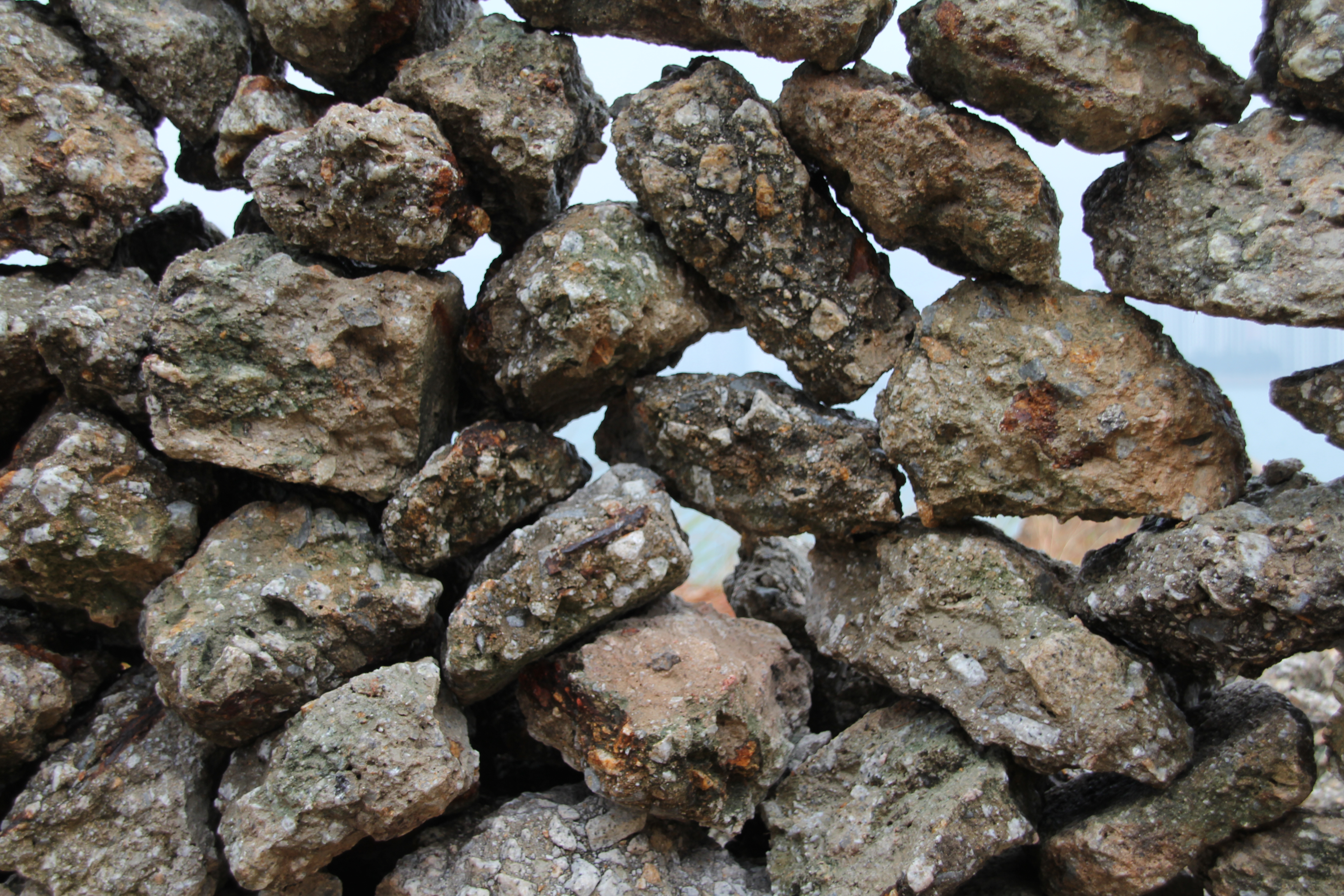 |
|
The students create the work “Echo” with the theme of “Void”. |
In 2014, besides the lectures in the lecture hall, Vincci invited students to experience four days and three nights camping in Lai Chi Wo and make creations through on-site observations. Vincci picked Lai Chi Wo because it is a 400-year-old Hakka village with Feng Shui forests, rivers, mudflats, and mangrove forests nearby. It reflects that the Hakka people knew how to use the environmental advantages and coexist harmoniously.
Vincci set five themes, "ecological footprint," "light," "soil," "wind/sound," and "water," hoping students could figure out the interaction between villagers’ lives and the environment. And to tell Lai Chi Wo’s stories from the perspective of the land.
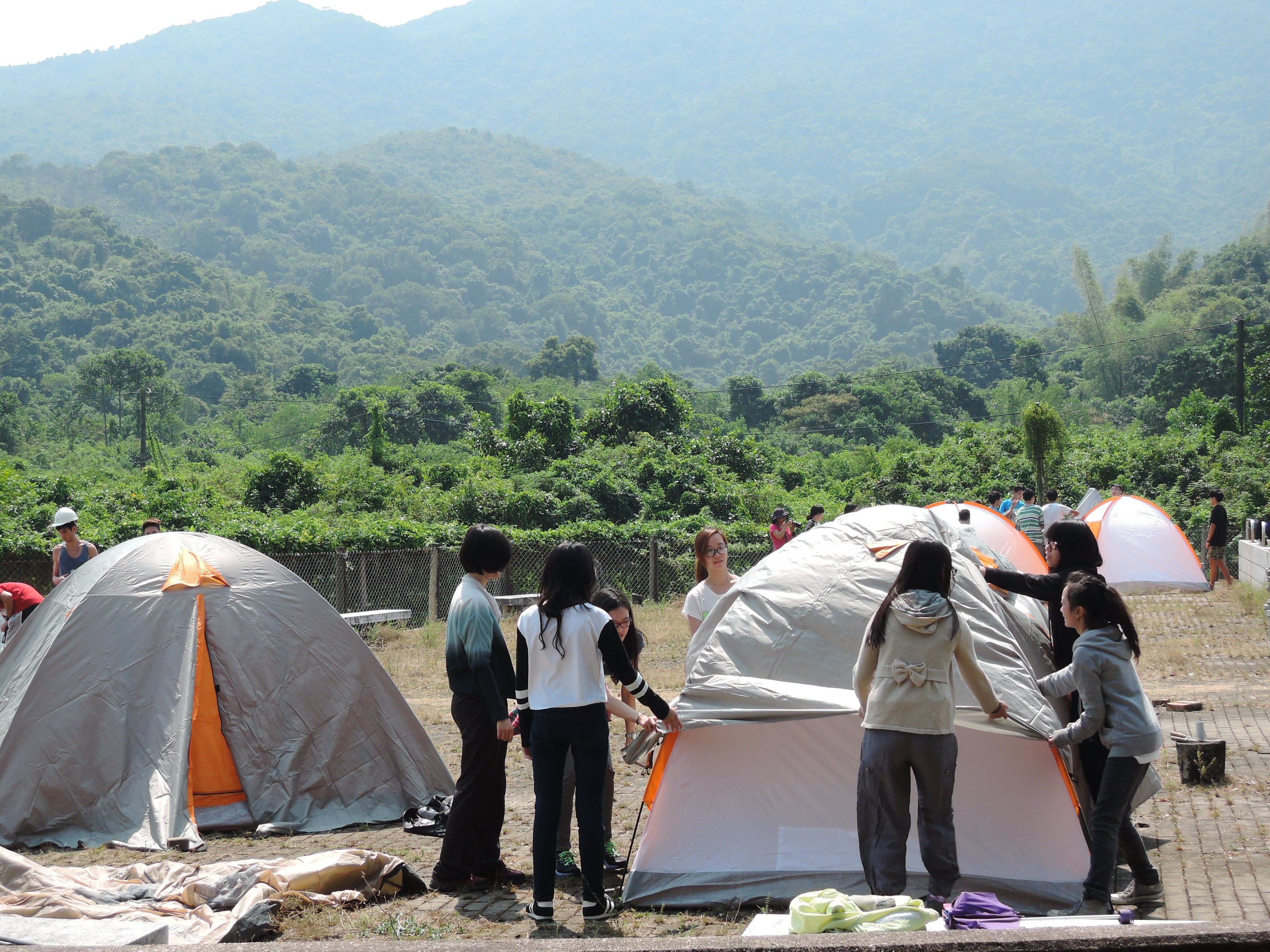 |
|
The students camp in Lai Chi Wo, take field trips and present their creations. |
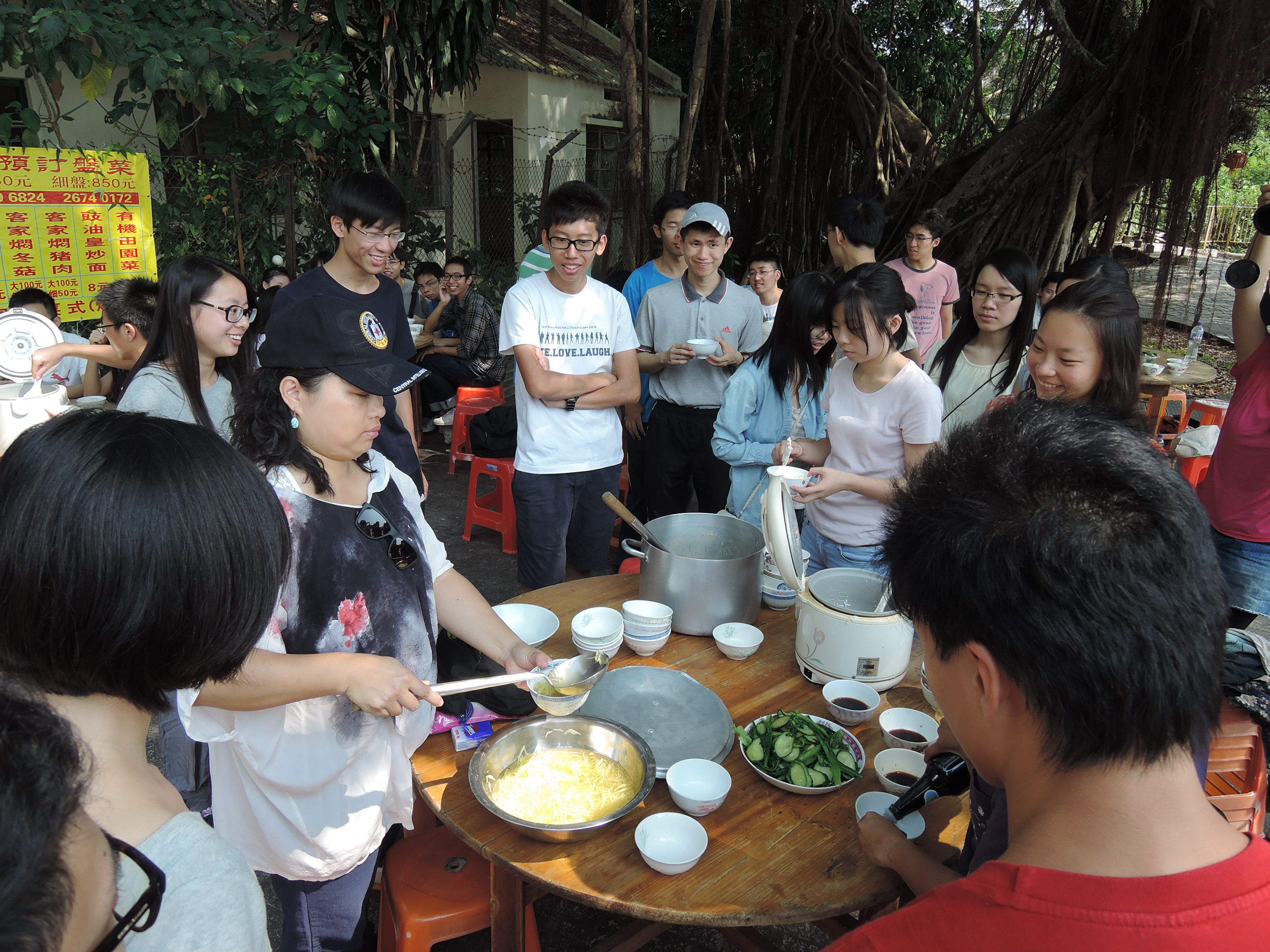 |
|
The students camp in Lai Chi Wo, take field trips and present their creations. |
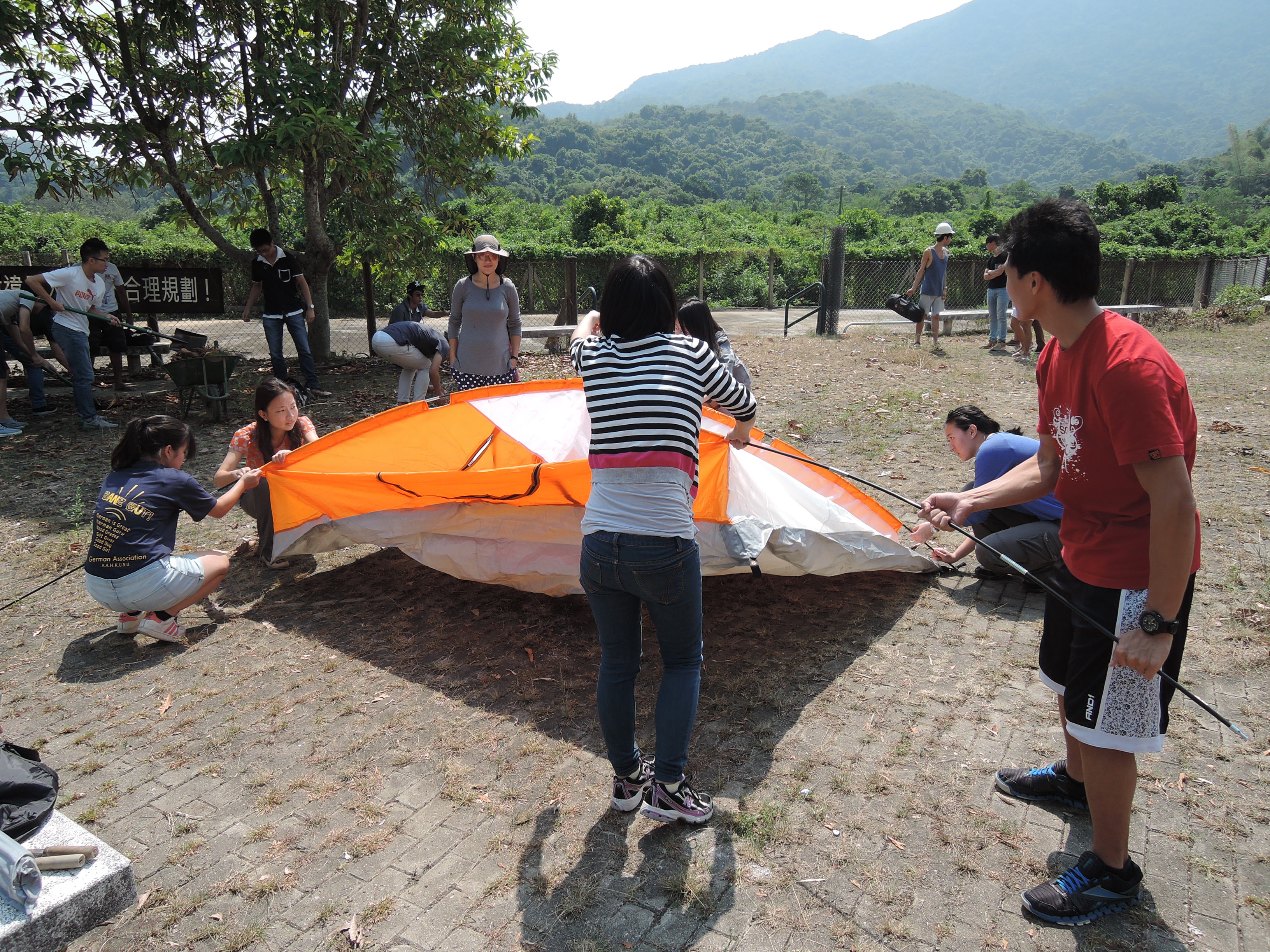 |
|
The students camp in Lai Chi Wo, take field trips and present their creations. |
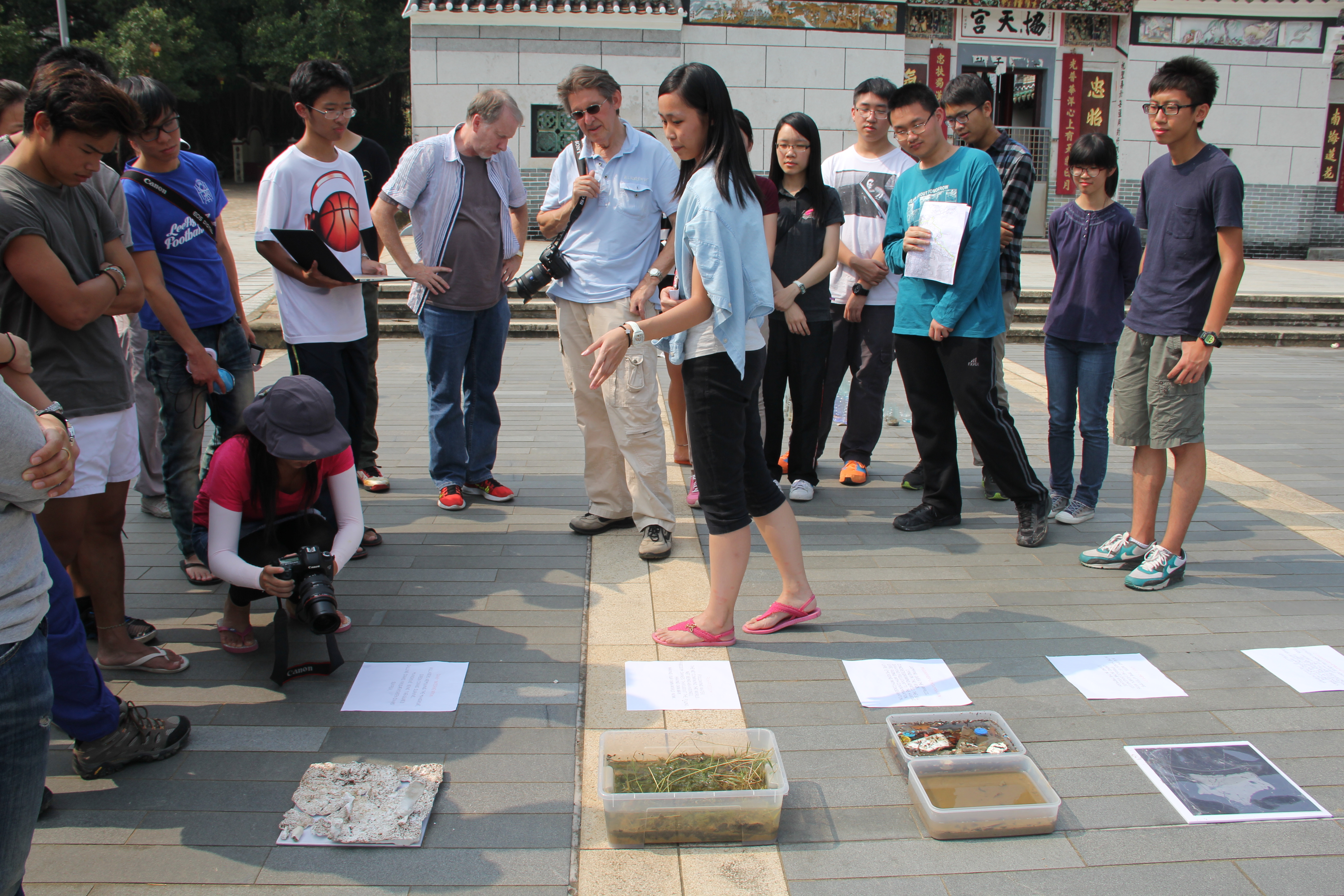 |
|
The students camp in Lai Chi Wo, take field trips and present their creations. |
"Langue des Terres” exhibition
Date: 14 November to 2 December 2014
Venue: G/F, 4 Pound Lane, Sheung Wan, Hong Kong
Selected works of students
Theme: Sound
Work: “As We Hear…”
Students: CHAN Yuen Sum, Daniel Hilel Edelson, Ip Chi Ching, Ip Jonathan Daniel, KOO Cheuk Ling Charlene, LAM Chak Yan, LAM Sin Kwan, LEE Ying Chik, NG Chak Ting, SHEN Chung Hang Pascale, SUM Hiu Fung Christopher, YUEN Ho Chun
Concept: Sound is intangible. Nature can also be intangible. This work invites the audience to listen to nature and understand the invisible side of the land. The students made a "sound cross-section", from the sea to the bamboo forest, to record the sounds of different places in Lai Chi Wo with short films and sounds.
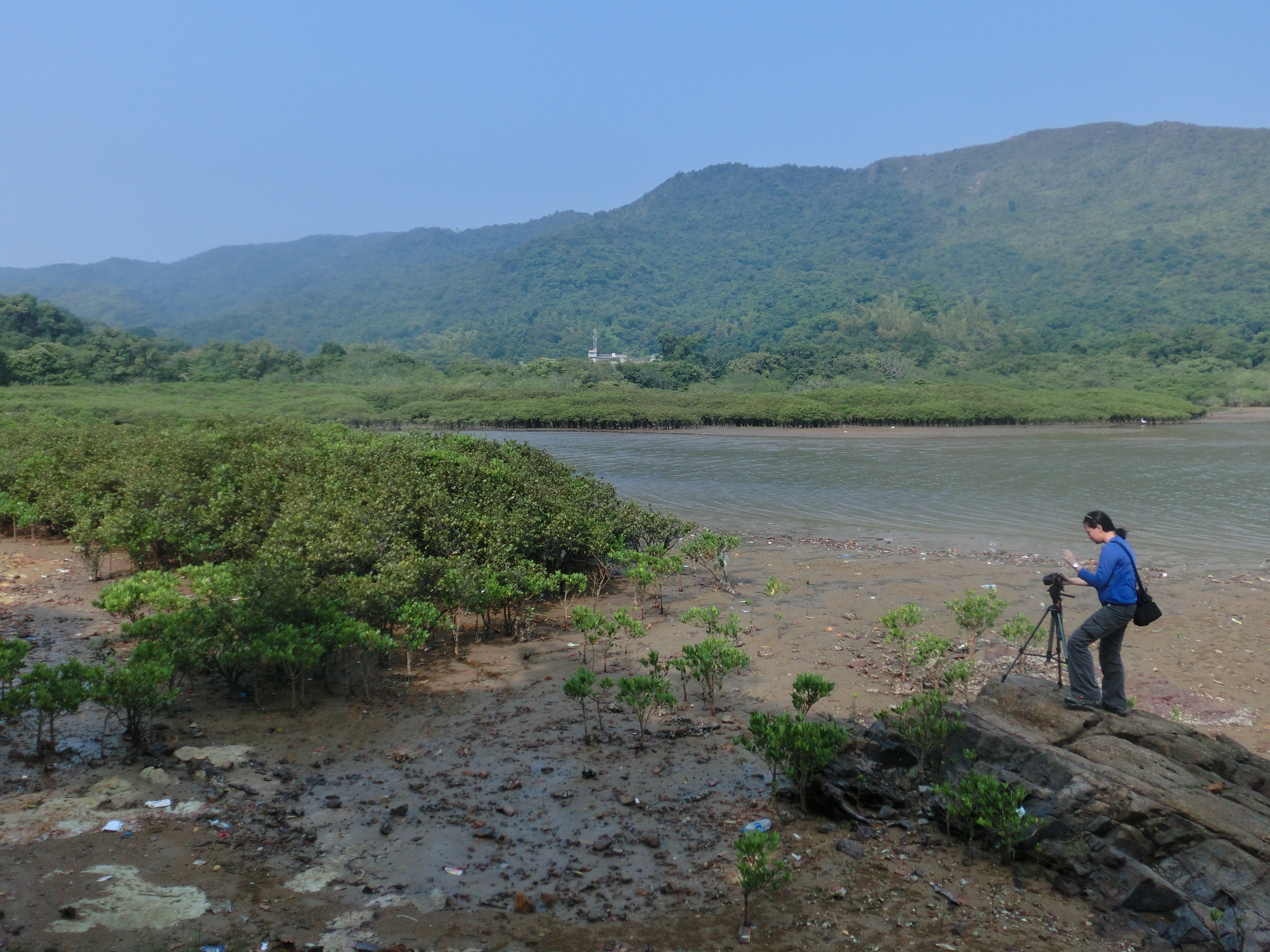 |
|
“As We Hear” (Sound): Students are recording the sounds of mangroves. |
Theme: Animals
Work: “Following The Traces”
Students: CHEUNG Chi Kit, CUI Dinghe, HO Mei Yee, KIM Ga Eun, LAU Chun Yin, LEE Hwanseo, LEUNG Yuen Lam, WAN Kwing San, WONG Mei Po, WU Xi, YIN Mingzhou, Zoya ZAHEER
Concept: Animals can tell us many stories about the land, including the characteristics of the land and the biological chain. This group of students used plaster molds to record the traces of animals in Lai Chi Wo, including bees, cows, dogs, spiders, mudskippers, fish, and fiddler crabs in the village.
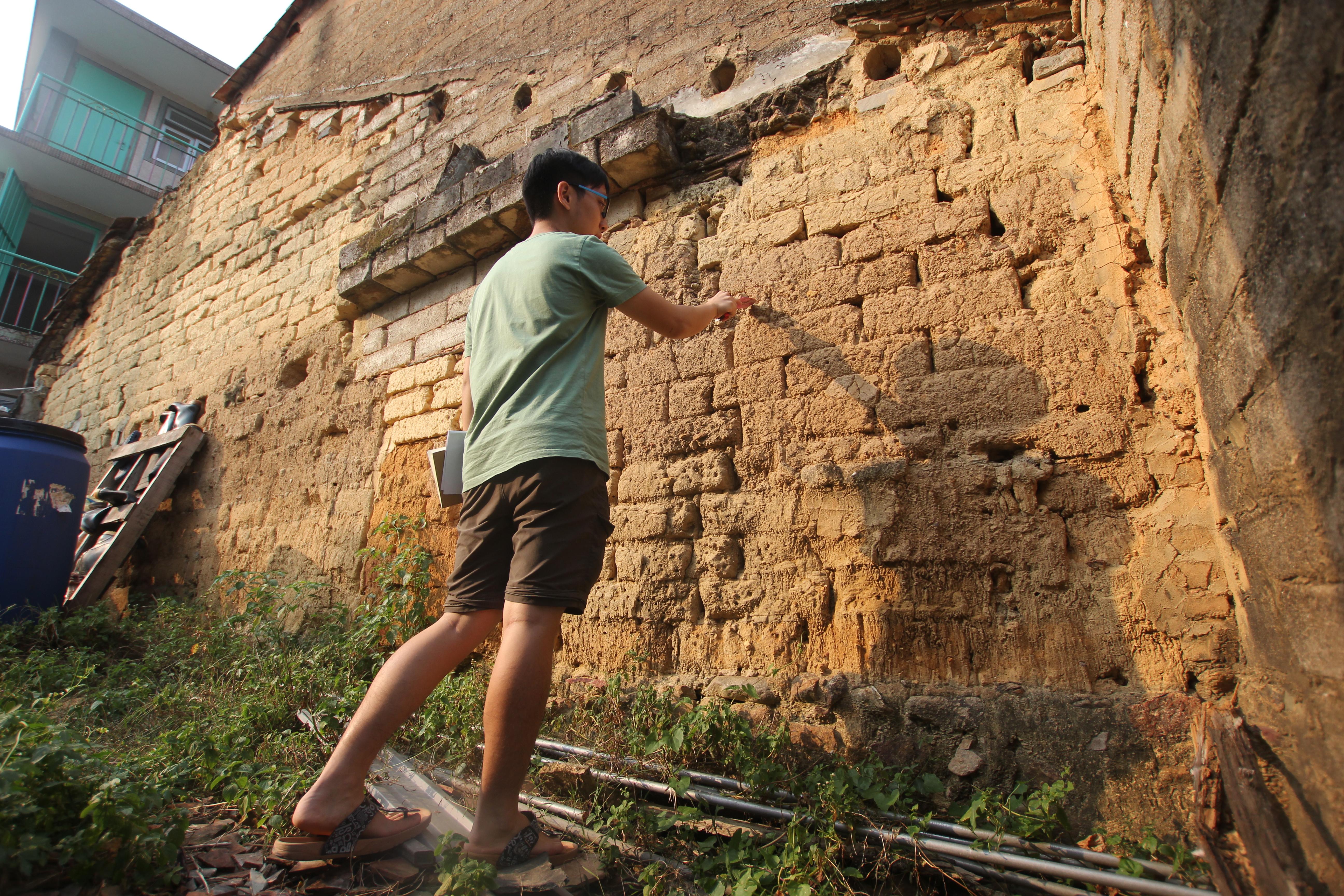 |
|
“Following The Traces” (Animals): Students are collecting traces of the hive. |
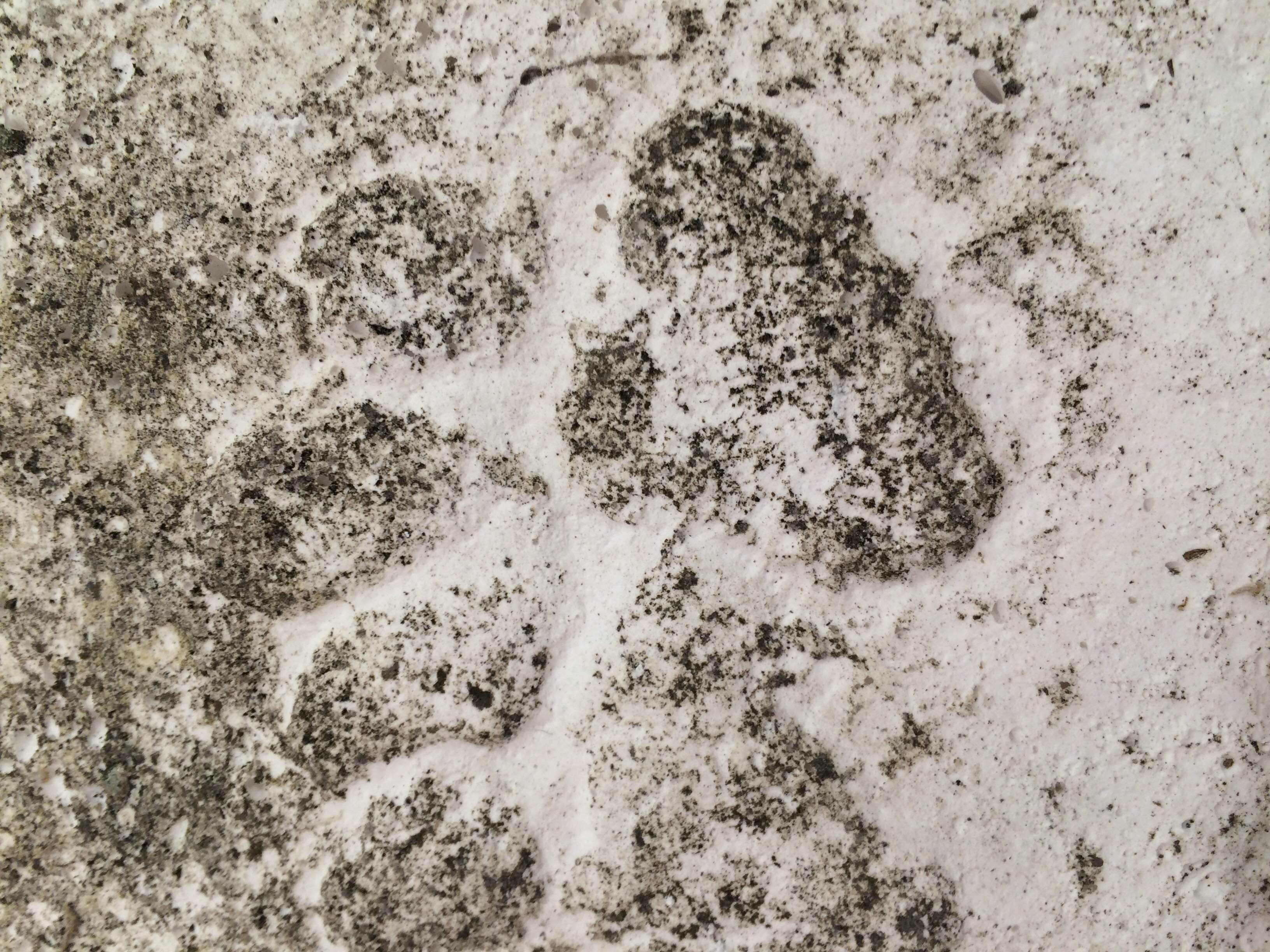 |
|
“Following The Traces” (Animals): The plaster mold was collected in Lai Chi Wo. |
Theme: Light
Work: “Light Chi Wo”
Students: CHAN Sze Chun Waaren, CHEUNG Wui Fung, NEW Saw Yu, POON Yan Lam, SIU Kit Wing, SYED Alim UI Razi
Concept: Light can be understood as a medium for exposing the land. Shaping the past, present, and future of Lai Chi Wo. The students were moved by the sunrise and sunset in Lai Chi Wo, hoping to observe the changes in light and shadow with their works. They regard the broken roofs, temples, and other places in the village as apertures and let light pass through these places into the lens of the camera, and the reflection of light forms another picture belonging to Lai Chi Wo.
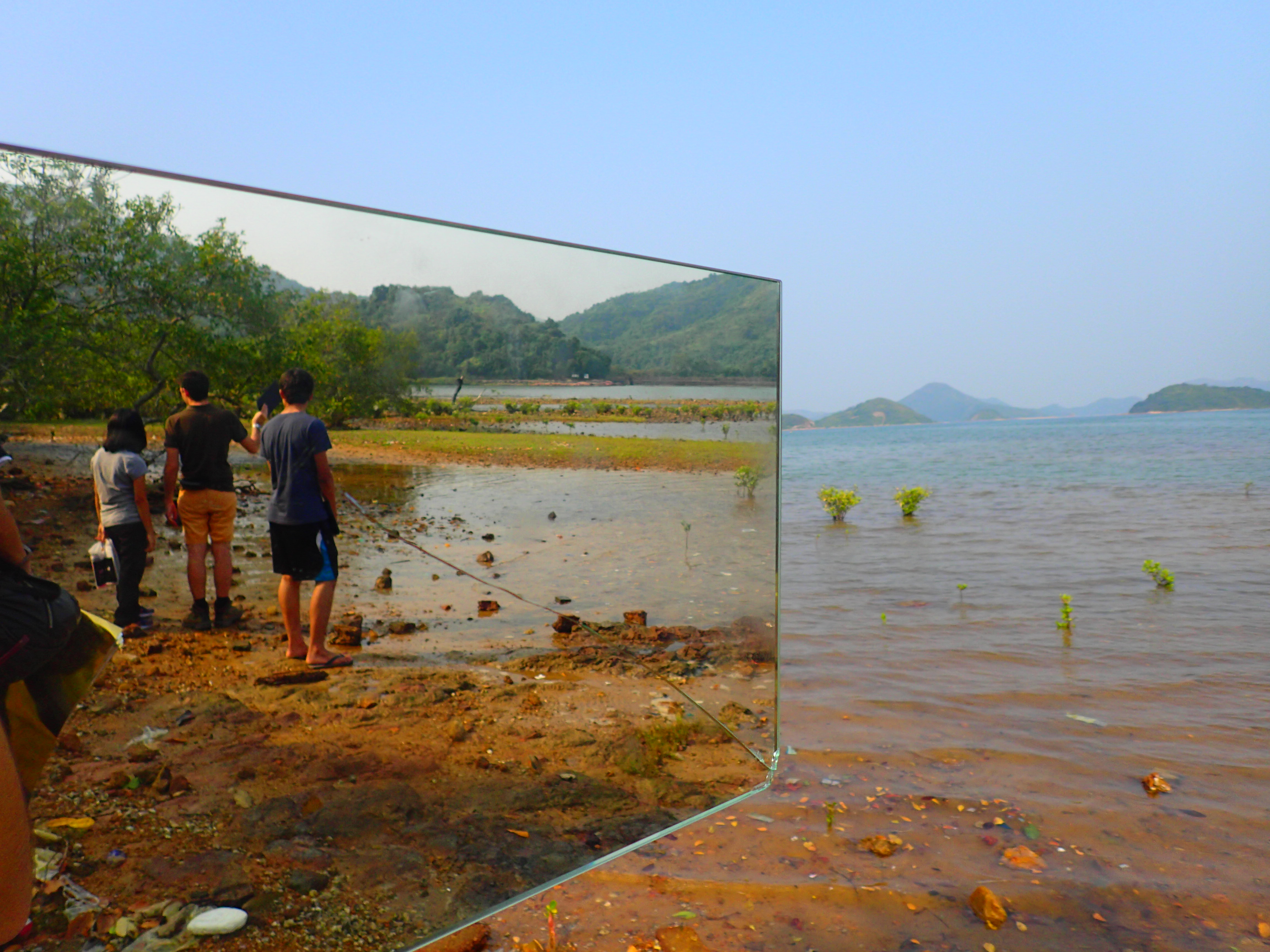 |
|
“Light Chi Wo” (Light): Students are exploring what the sky looks like in different places in the Lai Chi Wo and how it affects daily activities. |
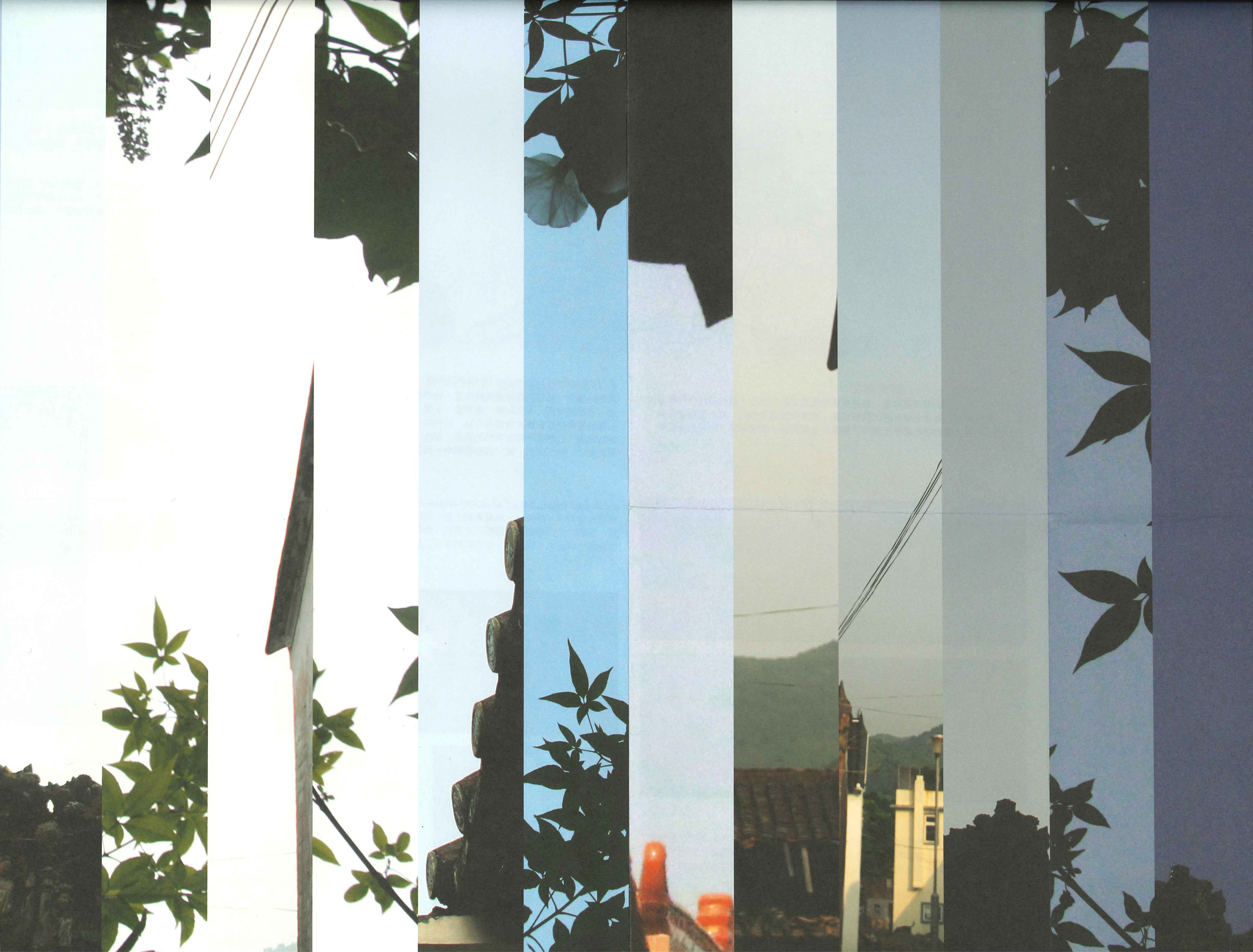 |
|
“Light Chi Wo” (Light): Students’ photography works. |
Theme: Soil
Work: “The Muddy Record”
Students: CHAN Lok Tim, CHAN Yuk Chun Jon, CHAU Kit Ying, CHIU Wang Yui, KWOK Chun Ho, Heranjithan MANOHARAN, Kaveesh SIVARAJ, TANG Man Lung, YEUNG Hin Oswin
Concept: The soil is weathered from stones and lasts for hundreds of years. Students collected soil samples from farmland, wetlands, rivers, and other places in the village and studied the various relationships between the soil and the villagers.
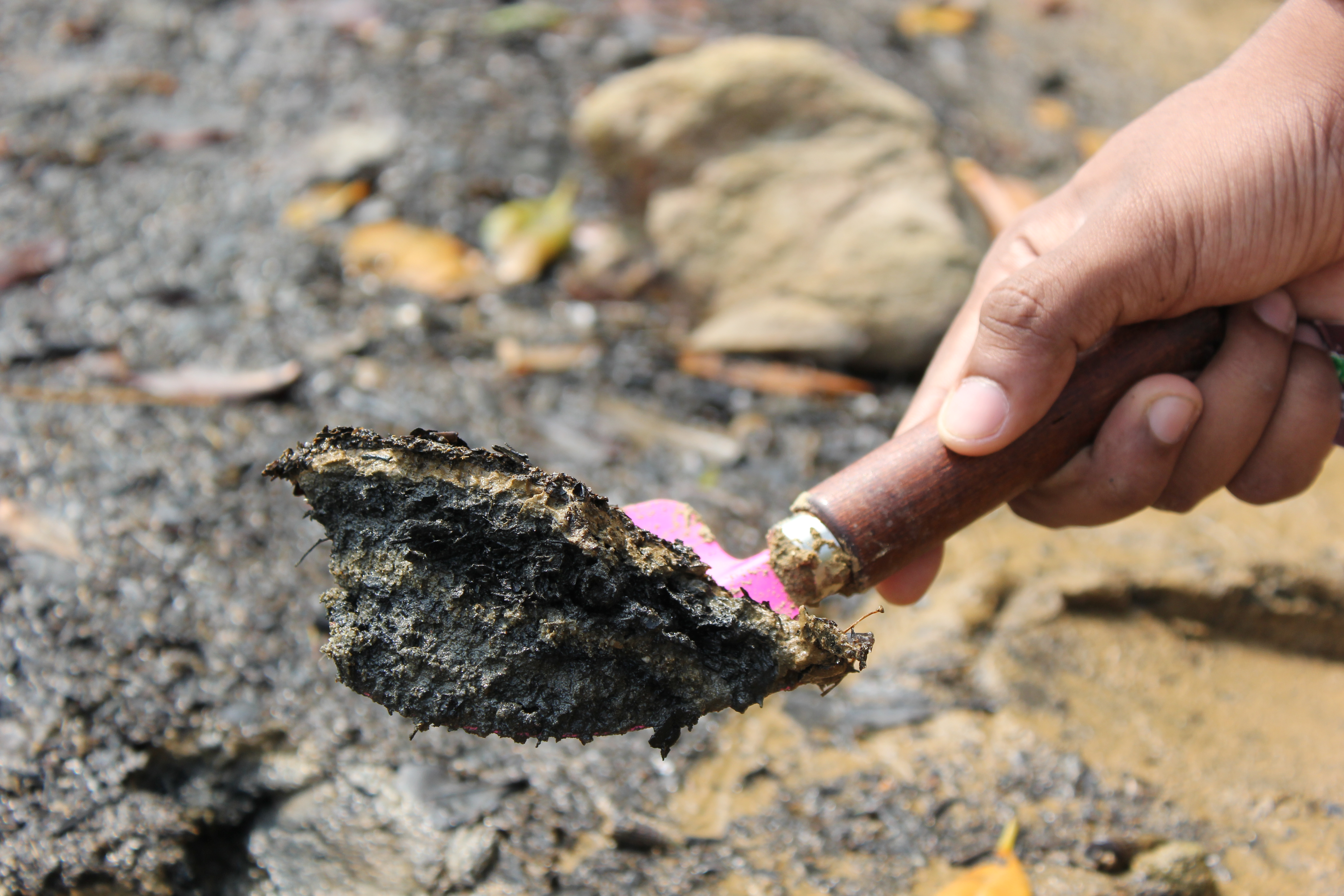 |
|
“The Muddy Record” (Soil): How does the soil composition in different places affect the activities of the village? |
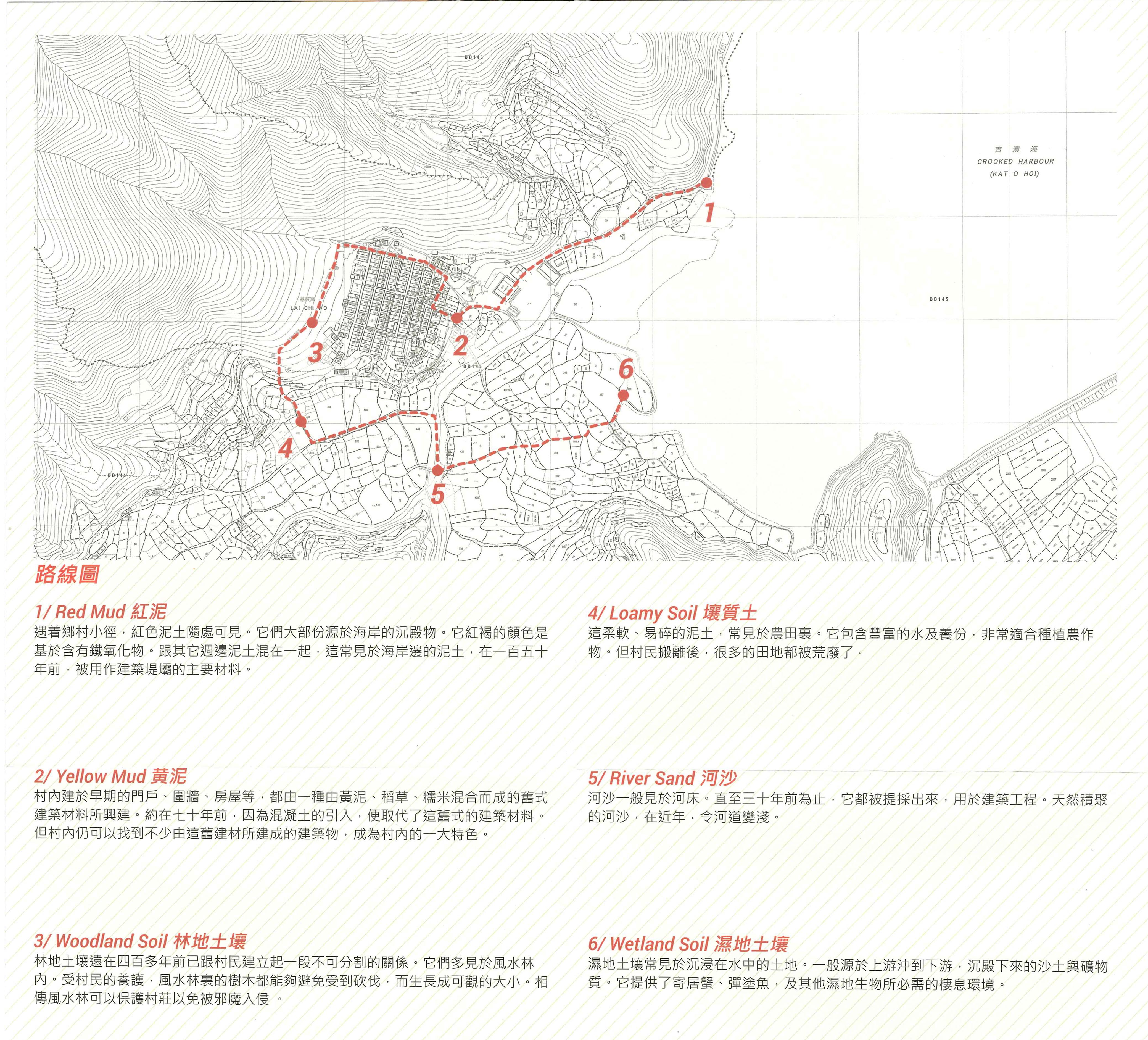 |
|
“The Muddy Record” (Soil): Students designed a map for Lai Chi Wo with soil as the topic, supplemented by text. |
Theme: Water
Work: “Optimal Habitats”
Students: CHAN Chun Hong, CHIU Ho Kwong, HONG Kin Wai, IU Nga Heng, JIANG Sifan, LAM Wing Sze, LEUNG Pak Sum, LU Yi Chin, LUK Sai Ting, POON Shuk Kwan, WONG Yu Hei
Concept: The river flows through the earth, shaping the earth under the earth's gravity. This group of students used glass bottles to collect five different water samples in Lai Chi Wo, including seawater, brackish water, domestic water, stream water, and irrigation water. They matched the waters with related objects to reflect the relationship between water and other species in the village.
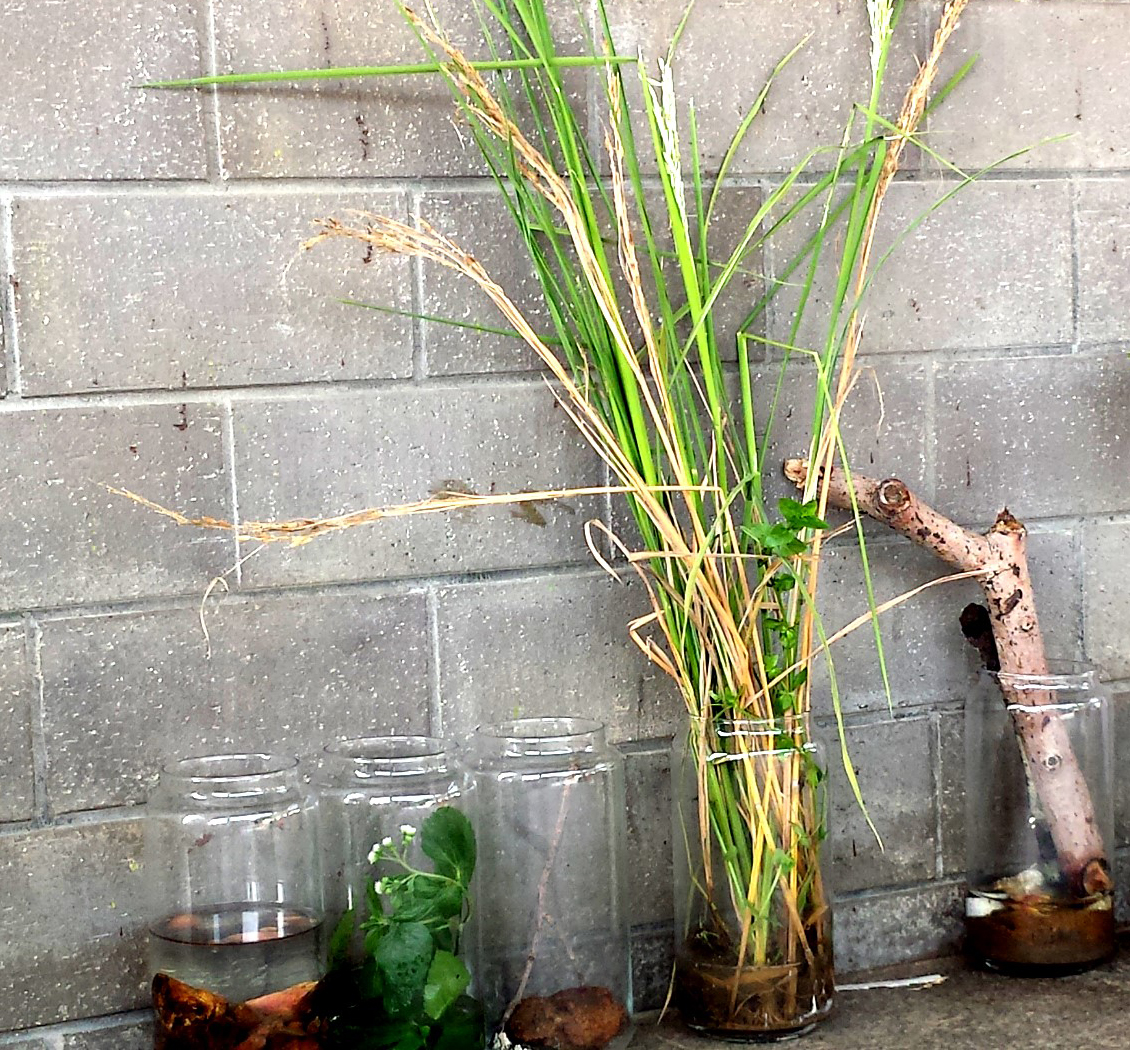 |
|
“Optimal Habitats” (Water): Rivers and shallows have bred countless lives, and life is integrated and respects water sources. |
After four days and three nights camping with students in Lai Chi Wo in 2014-15, the teaching team used Hong Kong's water resources as the theme in 2015-16 to inspire students to understand the story of water in this city. In the exhibition, the teaching team introduced:
“Human activities have been shaping the landscape through history for survival, cultural pursuit, and development of cities. When a city was established, proximity to freshwater supply was vital for survival. In old cities, the sophisticated system of freshwater collection, transport, storage, and distribution, demonstrated the early settlers’ pursuit of harmonious co-existence with nature, to take good care and make well use of the natural resource – water – in a sustainable way. (...)
In the early days of Hong Kong, we had limited freshwater supply. The British colonial government commissioned to construct the Pokfulam Reservoir and Conduit in the 1860s, relying on gravity to transport water from Pokfulam to the Central area. The Tai Tam Reservoir and Bowen Aqueduct were then built in 1880s to provide for the then-expanding city, transforming the tranquil hillside of the city for the purpose freshwater supply. The way that the early settlers had shaped the landscapes of the Hong Kong countryside in order to sustain freshwater for the city is still evident nowadays, though many parts are already in disuse as we purchase water from China’s Dongjiang.”
Vincci and the teaching team designed four directions about water in this academic year, using water monuments to explore the integration, tension, coexistence, and sacrifice between humans and nature, 1) commodification of the natural element of water, 2) human sensitivity and connotation with sounds of water, 3) use of materials for the construction and operation of the waterworks infrastructure, and 4) forgotten changes in the natural landscapes by historic waterworks.
Besides field trips and creations, students were also required to prepare written materials for public guided tours in this year's course.
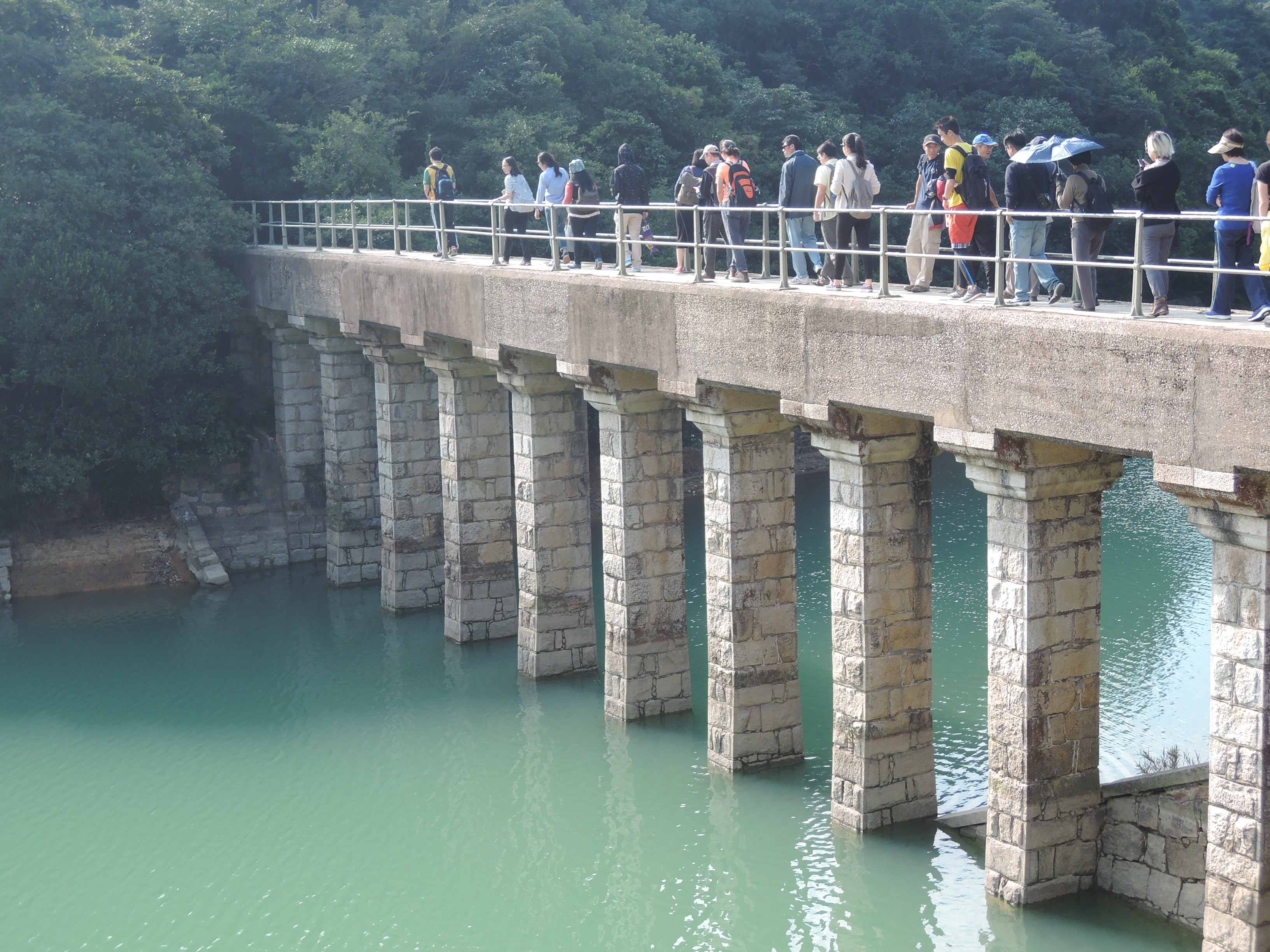 |
|
“Water For Sale! – Commodifying Nature”: Students are leading the public to visit the reservoir and share research results. |
“The WATER Collection” Exhibition
Date: 28 November to 12 December 2015
Venue: CACHe@ Annex Block (36A, Western Street, Sai Wing Pun)
Selected Works of Students
Work: “Water For Sale! – Commodifying Nature”
Students: CHAN Ching Yin, CHAN Sze Wah, CHEUNG Tsz Ching, CHUNG Wan Sau, FUNG Hiu Yan, HUI Lok Yung, LEE Ho Lung, TAM Tsz Ling, TONG Yiu Kiu, WONG Man Yu, YU Jose Chung Sze
Concept: "Through visiting the three most historically valuable water systems on Hong Kong Island: Pokfulam Reservoir, Tai Tam Reservoir, and Bowen Road Aqueduct, we explored the human commercialization of water resources. (...) Take pictures through the close-up lens to record our observations. We lifted the water covers, hoping to find and photograph different angles that reflect human-centered development."
 |
|
“Water For Sale! – Commodifying Nature”: Students' works in the exhibition |
Work: “Connecting The Elements”
Students: CHAN Chun Yin, HO Ming Yan, LAI Ka Long, LAW Wing Sze, LEE Jonathan Oswald, LEE Cho Ching, LI Ting Lok Gabriel, LI Hao Lin, LI Yim Ni, SUEN Fai
Concept: "This work is to trace the source of the materials used in the Tai Tam Reservoir Project. To illustrate this story, we used different recording methods to display the materials according to the different locations shown on the map. (... ) We used pencils across the paper to rub the texture of the material, capturing the texture of metal water pipes, bricks, granite, and other materials that change over time."
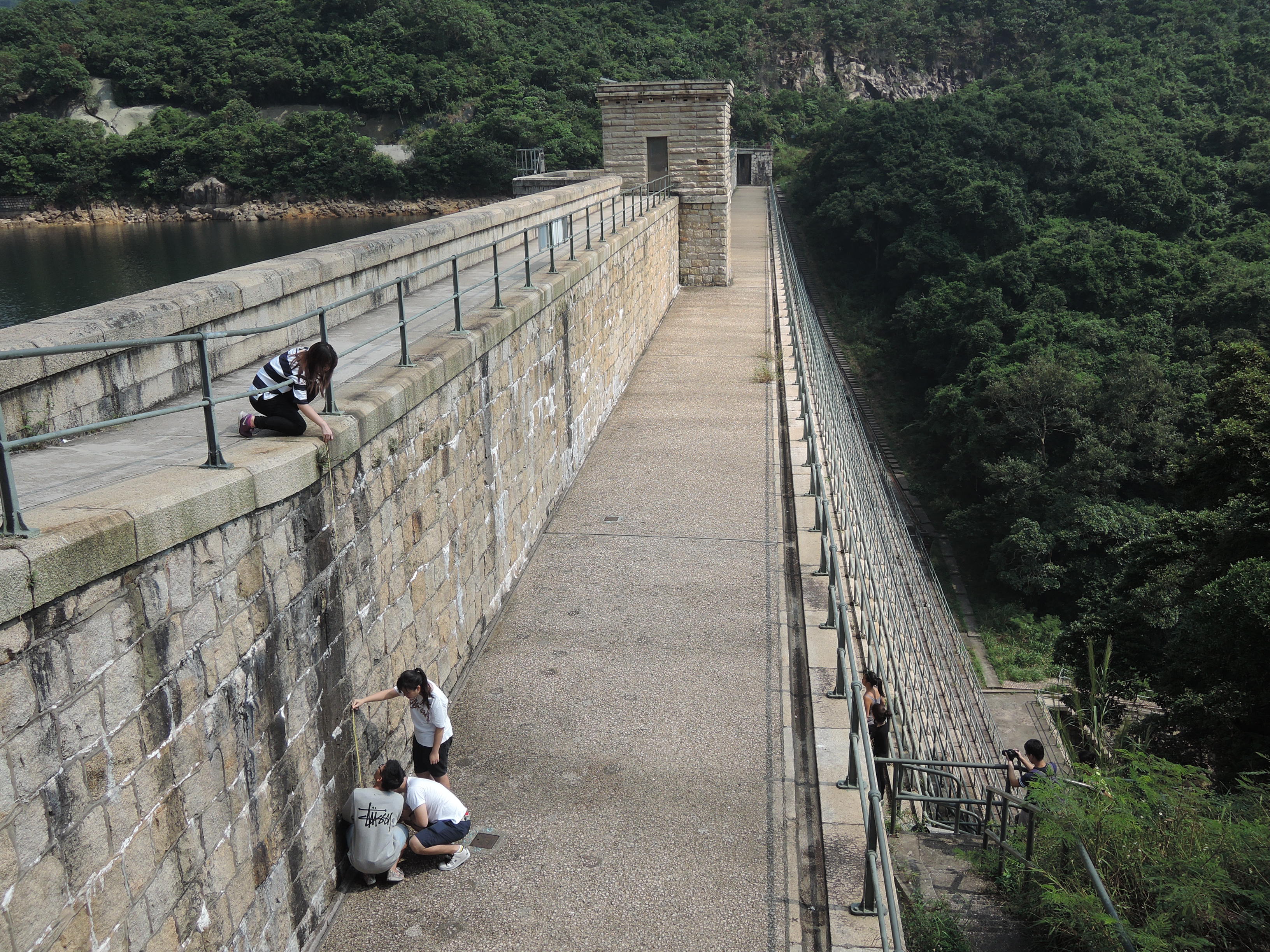 |
|
“Connecting The Elements”: Students study different materials in Tai Tam Reservoir. |
Work: “SOUND of the unheard”
Students: CHEUNG Chun Hin, CHAN Hin Hung, CHEUNG Hoi Ching, CHEUNG Hoi Yiu, CHU Man Ka, GURUNG Sumichhya, LAU Ching Luen, NG Kwok Jing, WONG Tsz Ching
Concept: The work of this group of students has three parts. "Tai Tam - Piped Landscapes" collects sounds from the ground and sends them back to the ground with a pipe, inviting the audience to imagine the underground world. "Tai Tam - Small Voices, Loud Impact" uses a series of cone-shaped models to build the surface of the pond, and at the same time, brings the sound of the faucet to Tai Tam, combining the sound of the pond with the sound of the household faucet. "Bowen - Walkable Waves" uses an electric fan to make waves of water and place them on Bowen Road where it used to be the location of water pipes.
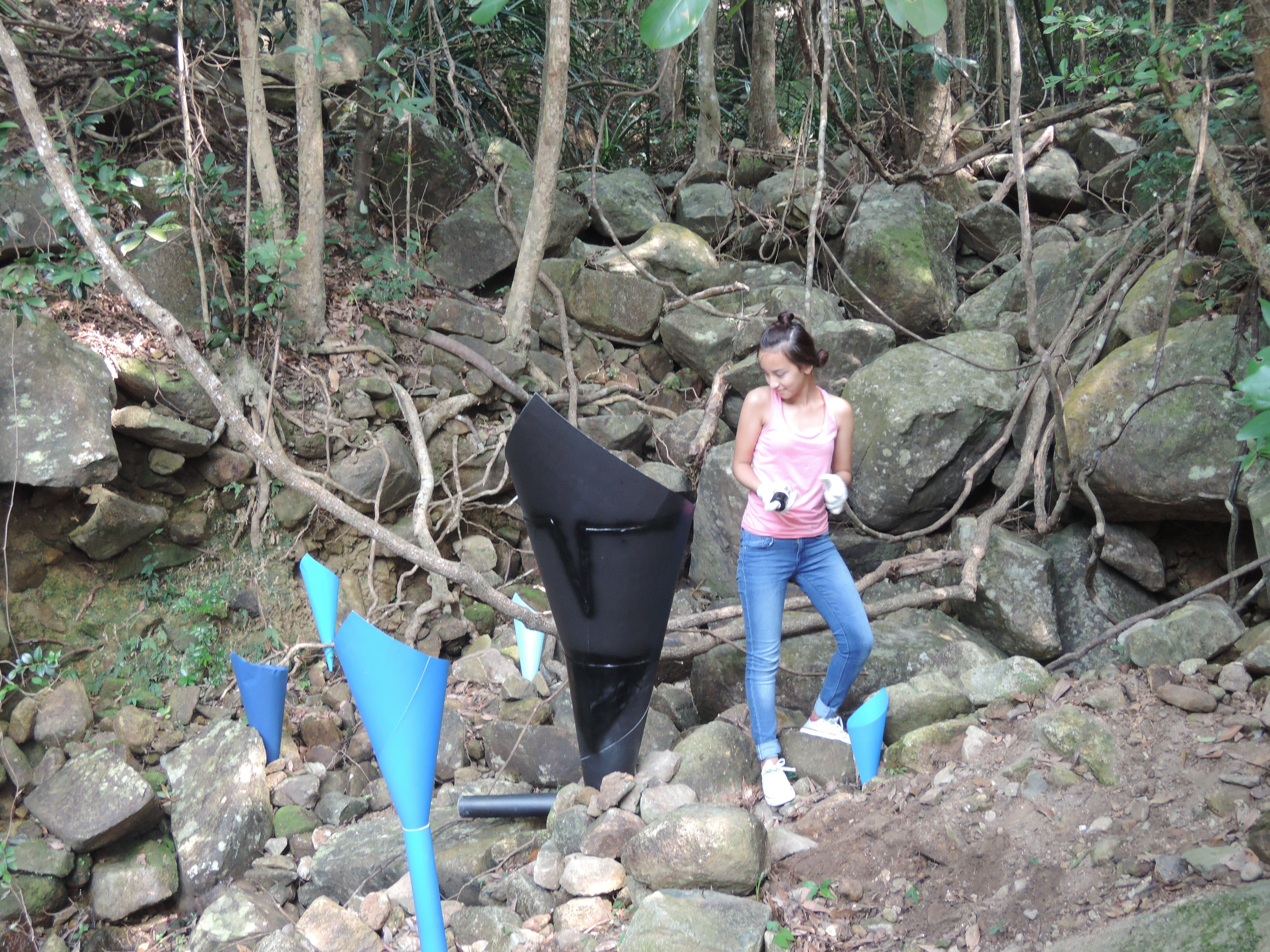 |
|
“SOUND of the unheard”: Students are on-site creating at Bowen Road. |
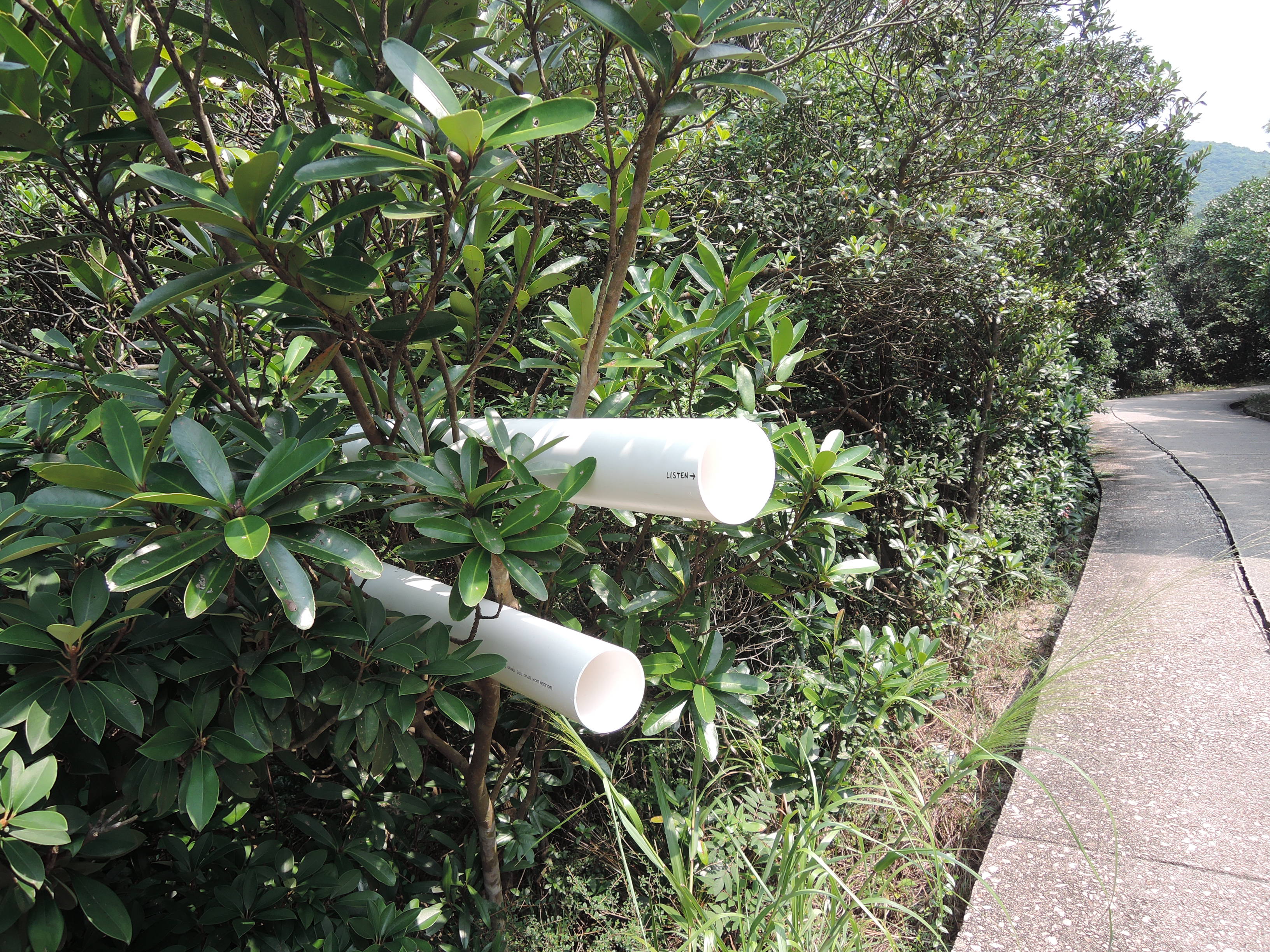 |
|
“SOUND of the unheard”: Students are on-site creating at Bowen Road. |
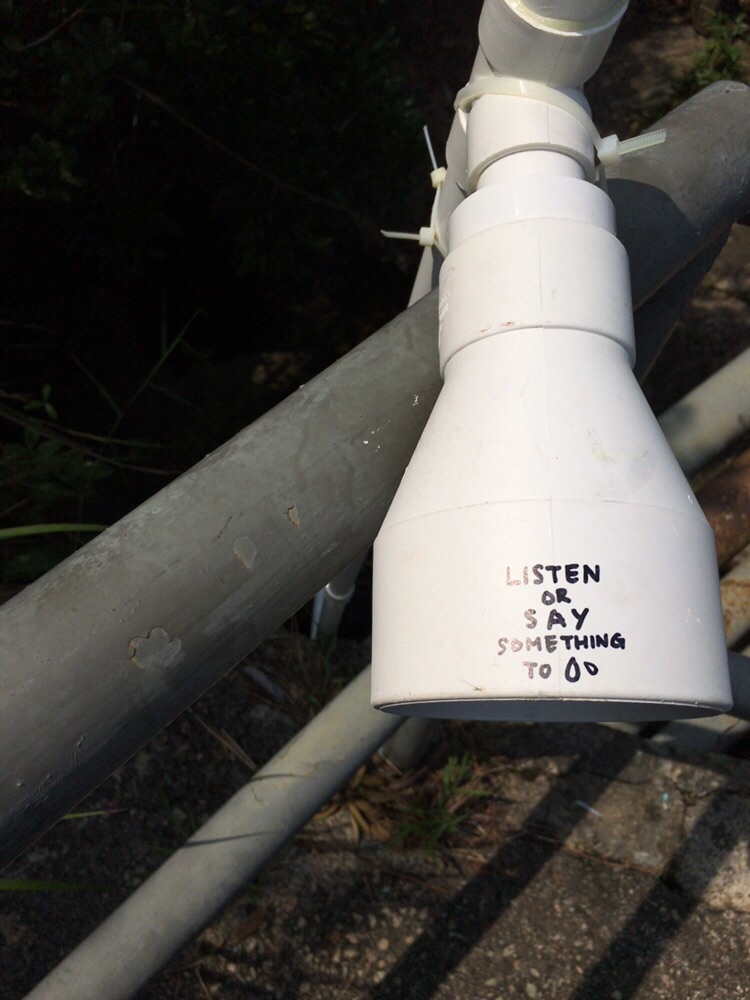 |
|
“SOUND of the unheard”: Students are on-site creating at Bowen Road. |
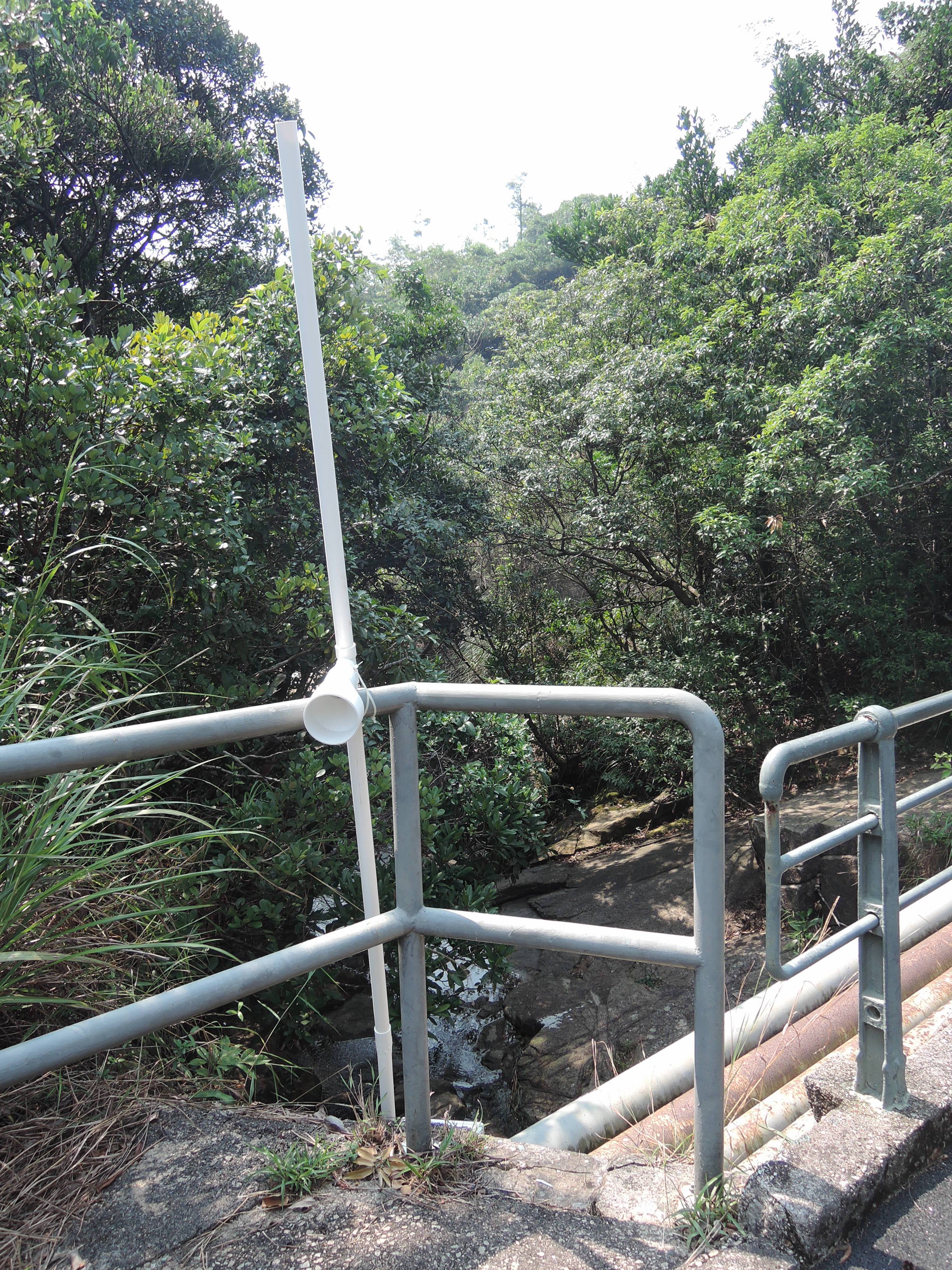 |
|
“SOUND of the unheard”: Students are on-site creating at Bowen Road. |
Work: “Remembering Drought – Hong Kong Landscapes Before the Aqueducts”
Students: CHAN Kwun Kit, CHAN Shu Man, CHEUNG Ka Wah Francis, HO Ngai Hei Ernest, HWANG Ye Sun, HO Sin Yee, LEE Tat Sing, TSANG To
Concept: "Our art installation allows viewers to focus on water facilities that are now out of service and only a few people have noticed. They contain forgotten memories of life. (...) We have used different methods to expose these rich historical symbols." This group of students used the methods of restoration, construction, concealment, and archiving to record the stories of Tai Tam Reservoir.
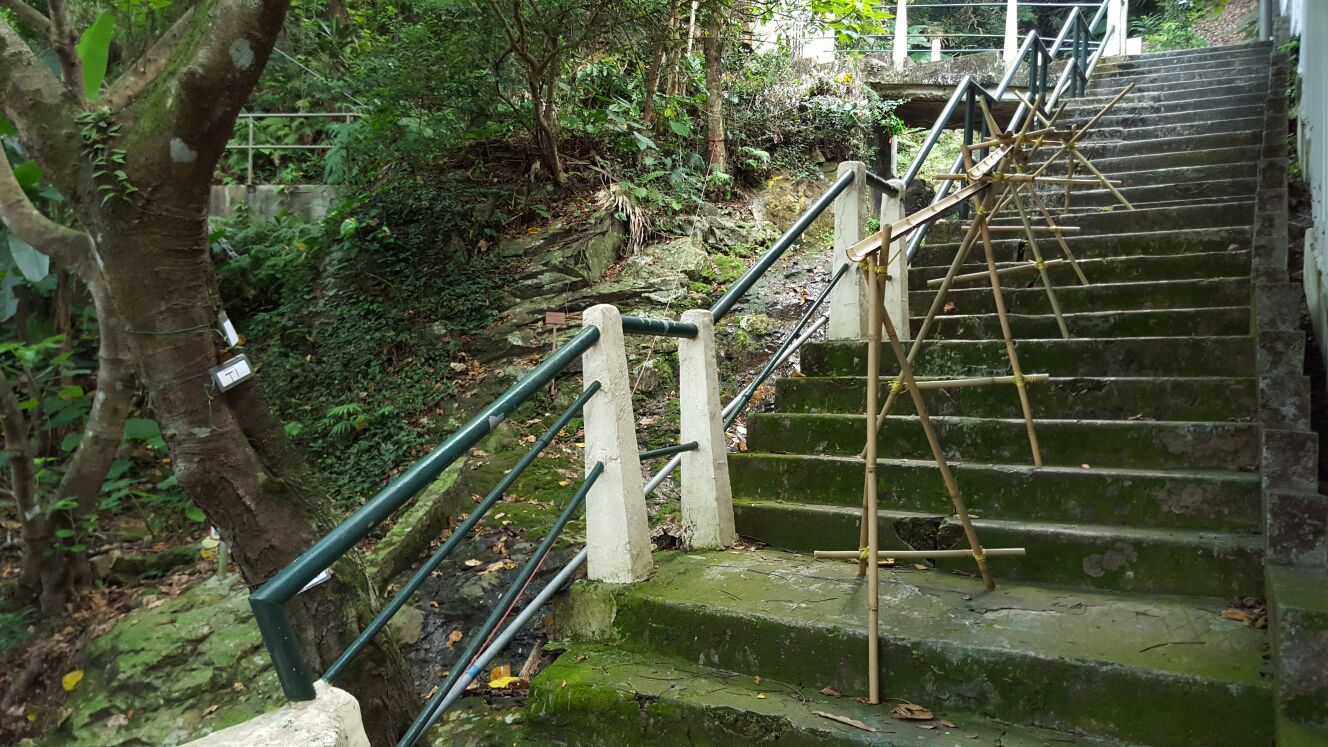 |
|
“Remembering Drought – Hong Kong Landscapes Before the Aqueducts”: The students rebuilt the ancient bamboo water pipes by "building." |
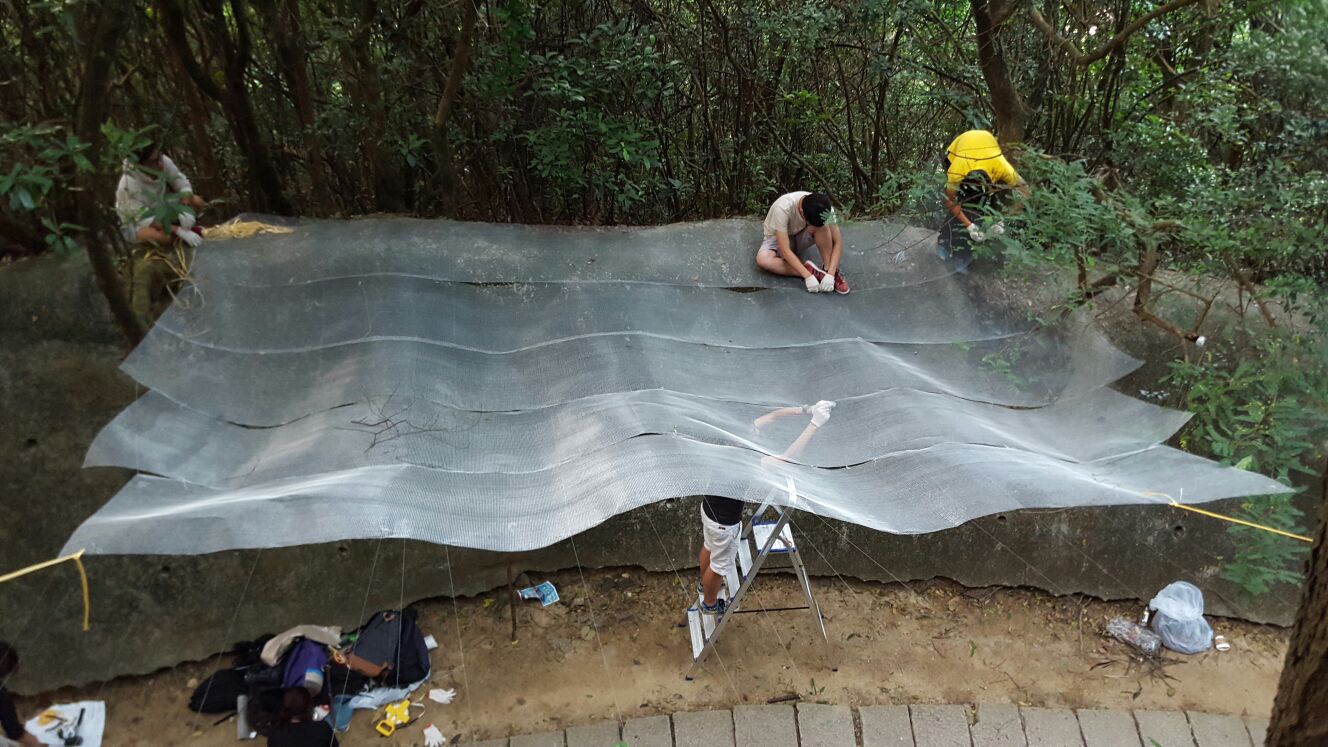 |
|
“Remembering Drought – Hong Kong Landscapes Before the Aqueducts”: Students used rehabilitation as a method to restore the original appearance of the hillside terrain through barbed wire. |
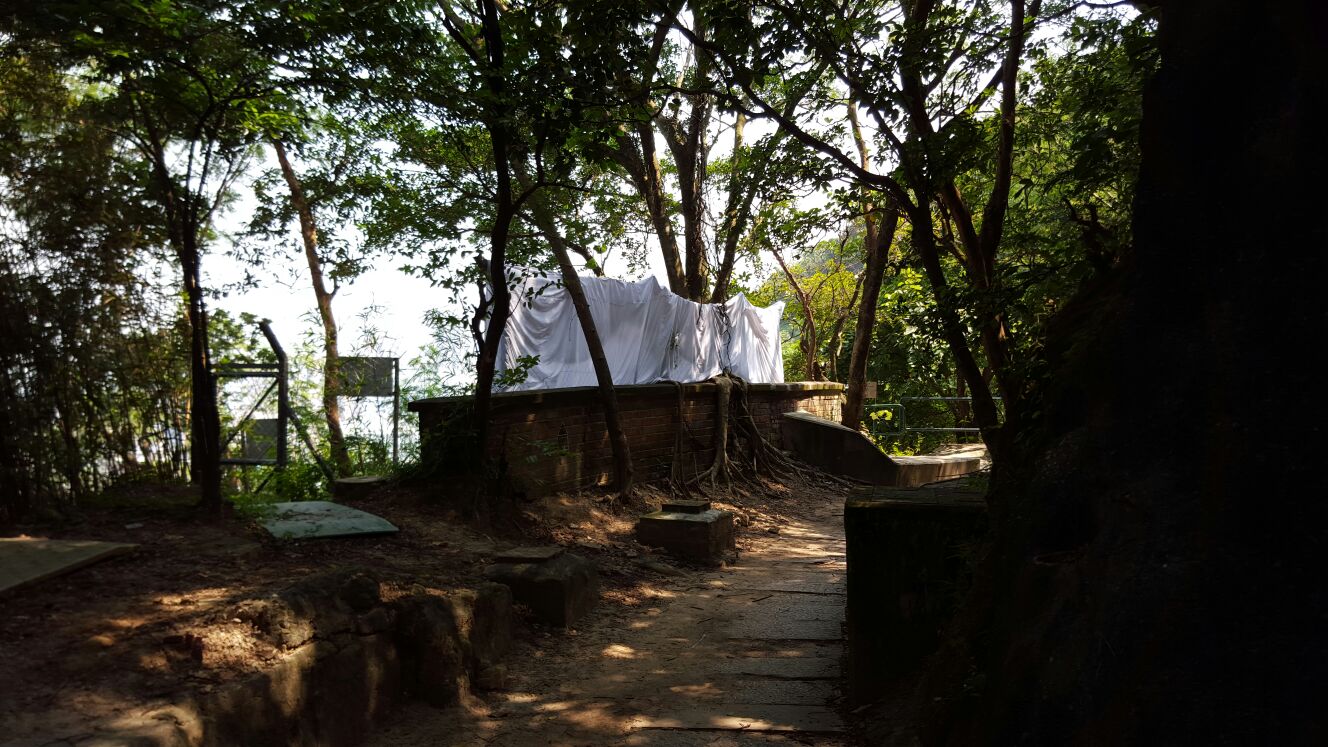 |
|
“Remembering Drought – Hong Kong Landscapes Before the Aqueducts”: Students covered fences and modern water conservancy facilities in a hidden way, highlighting the stone walls and old trees in the space. |
Six years have passed. The teaching team has brought a different learning experience to the university system, bringing students from the lecture hall to nature. What do students think? "Students must have different ideas. Some people were very involved, and some weren’t so involved." One of the students went to Japan to participate in a project about land art and emailed Vincci for advice. Vincci shared with the research team. For Vincci, she found that this liberal studies course had inspired some students and led them to continue their studies after graduation.
Although the course is over, still, Vincci is using other methods to promote land art at the university. "I have offered theoretical courses in the department and a more advanced study of land art. But I am also thinking about how to continue "Shaping the Landscape." If I have the opportunity to do it again, maybe I would consider teaching it as a non-credit experiential learning activity.” At the end of the interview, Vincci raised this point of reflection.
Link:
“Shaping the Landscape” Facebook: https://www.facebook.com/shapingthelandscape
© Unless otherwise stated, all photos courtesy of the Division of Landscape Architecture in the Faculty of Architecture, the University of Hong Kong. All rights reserved.